The differential success of alleles is
called_____________________.
Select one:
a. selection
b. genetic drift
c. fixation
d. migration
e. evolution
a. selection
All the alleles of all the genes present in a ll individuals in a
species are referred to as the _________ of that species
Select
one:
a. gene pool
b. allele frequency
c. genotype
frequency
d. genotype
e. phenotype
a. gene pool
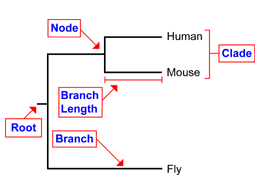
The tree below represents a phylogeny of different mammalian species. What is represented by the node?
Select one:
a. A recent speciation event
b. The
appearance of a new mutation
c. The appearance of a new genetic
variant
d. a common ancestor between human and mouse
e. a
mouse/human species
d. a common ancestor between human and mouse Correct
There are three alleles are a specific locus in a population of
humans. The alleles are D1, D2, and D3 and they have frequencies of
0.43, 0.30, and 0.28 respectively.
Select one:
a. D1 is
dominant
b. D1 is definitely not dominant
c. It cannot be
determined from this information whether D1 is dominant
c. It cannot be determined from this information whether D1 is dominant
With few exceptions, we can't use observable traits to measure
genetic variation in populations because:
Select one:
a.
observable traits don't vary enough among individuals to
measure.
b. we can't identify enough observable traits to be
useful, even if they could be measured
c. Most traits are only
represented by two alleles
d. You will only be able to measure
the dominant trait as the recessive one will be masked.
e. Many
traits are encoded by large numbers of genes and observable traits are
products of the environment as well as the genome
e. Many traits are encoded by large numbers of genes and observable traits are products of the environment as well as the genome
Interbreeding groups of organisms of the same species living in the same geographical area are called (one word, plural):
populations
Which of the following are conditions of for Hardy-Weinberg
equilibrium
Select one or more:
a. No differences in the
survival and reproductive success of individuals
b. Random
mating
c. No ongoing mutations
d. No migration
e. A
limited gene pool
a. No differences in the survival and reproductive success of
individuals
b. Random mating
c. No ongoing
mutations
d. No migration
At the genetic level, evolution is
Select one:
a. a change
in fitness over time
b. A population change over time.
c. a
change in the frequency of an allele or genotype over time
d. an
increase in fitness over time
e. natural selection
c. a change in the frequency of an allele or genotype over time
From an evolutionary perspective, germ-line mutations are more significant than somatic mutations. This is because:
Select one:
a. somatic mutations don't affect the genomes of
any cells
b. somatic mutations are generally harmful
c. only
germ line mutations will appear in an individual's descendants
d. only germ-line mutations can be harmful
c. only germ line mutations will appear in an individual's descendants
When the conditions of the Hardy-Weinberg equilibrium are met:
(select all)
Select one or more:
a. evolution occurs
b.
evolution does not occur
c. gene frequencies in the population
change over time.
d. gene frequencies in the population do not
change over time.
e. none of these occur when conditions of the
Hardy-Weinberg equilibrium are met.
b. evolution does not occur
d. gene frequencies in the population do not change over time
The number of complex multicellular organisms has increased over the
last billion years. Now think carefully about the question.
Select one:
True
False
true
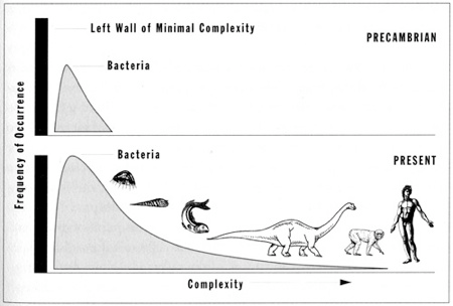
The graph below coupled with the answer to the last question suggests that natural selection would favor more complex organisms in a given situation.
True
False
False
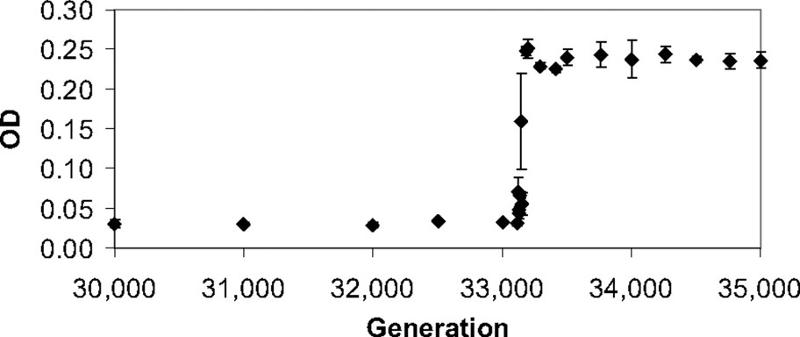
E. Coli cells were grown in a liquid broth that had limited glucose but was supplemented with citrate (a carbon source the bacteria couldn’t use directly, but is in the citric acid cycle), serially, for 35,000 generation (re-cultured every day and each sample frozen). In the experiment shown, a temporally representative subset of the cultures were individually cultured for 24 hours and the OD was compared. What does the O.D. MEASURE?
Select one:
a. Whether e. coli can survive on citrate
alone
b. the amount of bacteria in solution as measured by
diffracted light
c. How well each generation metabolizes
glucose.
d. The rate of bacterial growth
b. the amount of bacteria in solution as measured by diffracted light
Why did it take so many generations for the e. coli to be able to grow on citrate?
Select one:a. because e. coli grows much more slowly on citrate.
b. It needed to use up the glucose first
c. because mutations are random and just need to happen
d. because citrate is a very complicated molecule.
c. because mutations are random and just need to happen
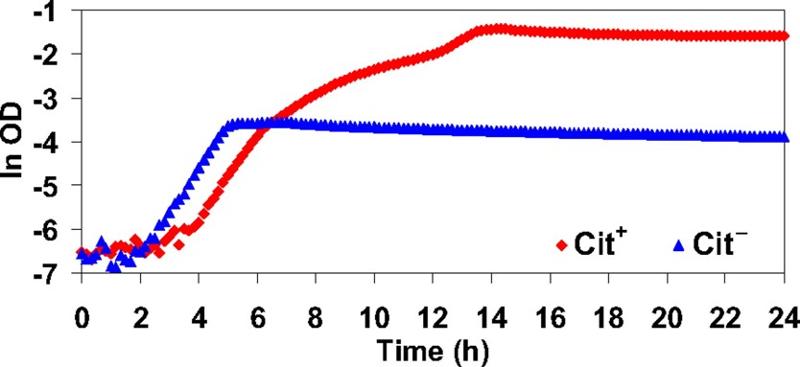
This chart shows the ln( OD) of two different cultures sampled over time. Cit+ can use citrate Cit- cannot. The authors of the study argue that both strains are using glucose only for the first few hours of growth. If this is correct, would the cit+ e. coli grow better in a citrate only medium or a high glucose medium (note that the experiment shown is with low glucose)?
Select one:a. citrate only
b. glucose only
c. you can't tell from these data, you'd have to do the experiment.
b. glucose only
Choose whether each is an example of acclimating or adapting to an environment. Either acclimatization or adaption
1.Training at high altitude increases the hemoglobin in a
cyclists blood
2.If you move from a cold to a hot
climate, the salt content of your sweat will eventually go
down.
3.A rare allele of a gene called EPAS1 helps people
thrive at low oxygen concentrations whereas the more common allele is
not as helpful. Most Tibetans have the rare allele whereas their
close (at least genetically) relatives the Han Chinese usually have
the common allele. In the Tibetans this is an example of.
4.The big ears of the long eared jerboa help it radiate heat in
the desert
1.acclimitization
2.acclimitization
3.adaption
4.adaption
In the c. coli long-term evolution experiment, the mutation allowing
the e. coli to metabolize citrate occurred because the e. coli were
growing on citrate.
Select one:
True
False
false
The differential success of alleles in leading to reproduction is
called _____________________
Select one:
a. Genetic
Drift
b. Selection
c. Fixation
d. Migration
e. Evolution
b. Selection
The result of migration is to ________ genetic differences among
populations
Select one:
a. Reduce
b. Increase
c.
It would depend on the distance of the migration
a. Reduce
Although each of the following has a better chance of influencing gene frequencies in small populations than in large populations, which one most consistently requires a small population as a precondition for its occurrence?
Select one:
a. Mutation
b. Nonrandom mating
c. Genetic Drift
d. Natural Selection
e. Gene Flow
c. Genetic Drift
In contrast to positive and negative selection, _______ favors the extremes instead of the the intermediate forms in a continuously varied trait .
Select one:
a. fixation
b. Disruptive
c. Stabilizing
d. DirectionalFeedback
b. Disruptive
Over time, the movement of people on Earth has steadily increased.
This has altered the course of human evolution by
increasing
Select one:
a. nonrandom mating
b.
geographic isolation
c. genetic drift
d. gene flow
e. speciation
d. gene flow
What is true of natural selection?
Select one:
a. Natural
selection is a random process.
b. Natural selection creates
beneficial mutations.
c. The only way to eliminate harmful
mutations is through natural selection.
d. Mutations occur at
random; natural selection can preserve and distribute beneficial
mutations.
e. Mutations occur when directed by the good of the
species; natural selection edits out harmful mutations and causes
populations to adapt to the beneficial mutations.
d. Mutations occur at random; natural selection can preserve and distribute beneficial mutations.
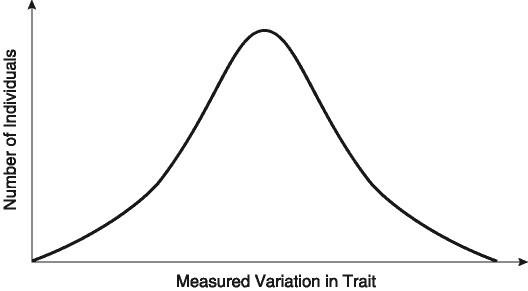
If the curve below shifts to the left or to the right, there is no gene flow, and the population size consequently increases over successive generations. Which of the following is (are) probably occurring?
Select one or more:
a. migration
b. directional
selection
c. adaptation
d. genetic drift
e.
disruptive selection
b. directional selection
c. adaptation
A hypothetical endangered species of wildflower has been reduced to a single small population in a mountain meadow. A group takes over the meadow in an act of anti-government defiance. They trample all but three of the flowers. This is an example of:
Select one:
a. natural selection
b. genetic drift
c. mutation
d. migration
e. non-random mating
b. genetic drift
The non-adaptive mechanisms of evolutionary change are:
Select
one:
a. migration (gene flow), mutation, and genetic drift.
b. migration (gene flow), balancing selection, and genetic
drift.
c. migration (gene flow), sexual selection, and genetic
drift.
d. mutation, sexual selection, and genetic drift.
e.
mutation, genetic drift, and heterozygote advantage.
a. migration (gene flow), mutation, and genetic drift.
Examine Figure 21.14. If you wanted to use a molecular clock to date
a relatively recent divergence event―say, one that occurred in the
last 100 million years or so―which of the four types of genes would
make the best clock? Why?
Select one:
a. Fibrinopeptides,
because they have changed the most over that time period.
b. A
histone gene, because it has changed relatively little over that
time.
c. Fibrinopeptides, because they have changed relatively
little over that time.
d. A histone gene, because it has changed
the most over that time period.
e. Hemoglobin, because of its
moderate rate of change.
a. Fibrinopeptides, because they have changed the most over that time period.
In a population of butterflies has the following gene frequencies:
60% AA, 20% Aa, and 20% aa. What is the frequency of the A
allele?
Select one:
a. 0.6
b. 0.8
c. 0.7
d.
0.2
e. 0.3
c. 0.7
With regards to the mouse whisker breeding program outlined above
which of the following are true?
Select one or more:
a. To
be successful the whisker length must be heritable
b. To be
successful whisker length must be governed by a single gene
c.
The whisker breeding program is not an example of artificial selection
because the mice are still breeding naturally.
d. Reproductive
success is not important in this case because you are choosing who mates.
a. To be successful the whisker length must be heritable
All the alleles present in all individuals in a species are referred
to as the ____________ of that species.
Select one:
a. gene
pool
b. allele frequency
c. genotype frequency
d.
genotype
e. phenotype
a. gene pool
Which of the following is a true with respect to genetic
variation?
Select one:
a. Genetic variation is created by
natural selection.
b. It arises in response to environmental
change.
c. It must be present in a population before natural
selection can act upon the population.
d. It tends to be reduced
by meiosis.
c. It must be present in a population before natural selection can act upon the population.
The differential success of alleles is
called_____________________.
Select one:
a. selection
b. genetic drift
c. fixation
d. migration
e. evolution
a. selection
From an evolutionary perspective, germ-line mutations are more
significant than somatic mutations. This is because:
Select
one:
a. somatic mutations affect only one or a few cells.
b.
somatic mutations are generally harmful.
c. only germ-line
mutations will appear in an individual’s descendants.
d. only
germ-line mutations are potentially beneficial to the
individual
e. somatic mutations affect only one or a few cells
and only germ-line mutations will appear in an individual’s descendants.
c. only germ-line mutations will appear in an individual’s descendants.
Which of the following big sagebrush plants is the most fit, based
only on the information in the answers?
Select one:
a. The
individual that can survive with 10% less water than the others in its
population.
b. The individual that produces 5% more distasteful
chemicals, making it 2% less likely to be attacked by herbivores than
others in its population.
c. The individual that produces 3% more
offspring each year than others in its population.
d. The
individual that is the most resistant to disease organisms in the
population.
e. All of these individuals are equally fit based on
the information presented.
c. The individual that produces 3% more offspring each year than others in its population.
At the genetic level, evolution is
Select one:
a. a change
in fitness over time
b. A population change over time.
c. a
change in the frequency of an allele or genotype over time.
d. an
increase in fitness over time
e. natural selection
c. a change in the frequency of an allele or genotype over time.
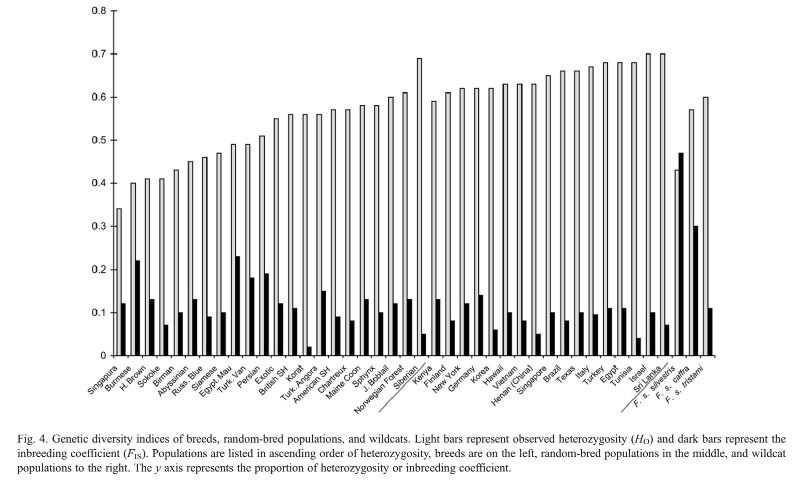
The chart below shows heterozygosity and the inbreeding coefficient for cats. Inbreeding coefficient approaches 1 when there is a great deal of inbreeding and 0 when there is none. For the purposes of this question you only need focus on heterozygosity (discussed in class) To the left of the grey line on the bottom are breeds of cats (Singapura through Siberian). To the right of the grey line are random bred cats (mutts) from the localities listed. The last three on the right are wild cat populations. Felis silvestris silvestris is a small wild cat native to Europe and much of Africa, Felis silvestris caffra is the south african wildcat and Felis silvestris tristami (another wild cat). Given these data, w hich of the following statements are true? (lipinski et al 2007 Genomics). Please note, these data are based on microsattelites in the genome not on coding regions, they can be used to make predictions, but shouldn't be taken as the final word.
Select one or more:
a. Wild cats likely have a larger gene
pool than domesticated cats.
b. Random bred cats would probably
be able to adapt to changes in the environment better than cat
breeds
c. The low heterozygosity in Felis silvestris silvestris
(F.S. silvestris) could be due to a large population.
d. The low
heterozygosity in Felis silvestris silvestris (F.S. silvestris) could
be due to a very small population.
e. The cat with the smallest
gene pool is the Singapura.
b. Random bred cats would probably be able to adapt to changes in the environment better than cat breeds
d. The low heterozygosity in Felis silvestris silvestris (F.S.
silvestris) could be due to a very small population.
e. The cat
with the smallest gene pool is the Singapura.
Which of the following is necessary for evolution by natural
selection?
Select one or more:
a. Variation in heritable
traits in the population
b. Differences in lifetime reproductive
success based on traits
c. there must be sexual
reproduction
d. some dramatic change in the environment.
a. Variation in heritable traits in the population
b.
Differences in lifetime reproductive success based on traits

Mouse whisker fanciers enjoy raising pet mice but they are very fussy about the whisker length. They like the whiskers to be as close as possible to 2.5 cm long, a very fine whisker length indeed. You wish to raise mice to take advantage of the mouse fanciers' shallow desires and deep pockets. You know nothing of mouse whisker genetics. You begin with a breeding population of several thousand mice with a whisker distribution as shown below:
What should your breeding program be like?
Select
one:
a. Breed mice from I and III so that you get heterozygous
mice.
b. Select mice from II and III to breed so as to raise the
average whisker length.
c. Choose mice in section II only and
breed them to try to stabilize the whisker length around 2.5 cm.
d. Choose mice from III only to breed so as to raise the
average whisker length.
c. Choose mice in section II only and breed them to try to stabilize the whisker length around 2.5 cm.
What does the biological species concept use as the primary criterion
for determining species boundaries?
Select one:
a.
geographic isolation
b. niche differences
c. gene flow
d. morphological similarity
e. molecular (DNA, RNA,
protein) similarity
c. gene flow
When you use a field guide to identify a species by its appearance,
you are applying the
Select one:
a. Evolutionary species
concept
b. Biological species concept
c. morphospecies
concept
d. ecological species concept
c. morphospecies concept
A drawback of the BSC is that it cannot be applied to
Select one or more:
a. polymorphic species (like ants)
b. asexual organisms like bacteria
c. extinct organisms like dinosaurs
d. plants
e. none of these are drawbacks
b. asexual organisms like bacteria
c. extinct organisms like dinosaurs
A bacteriologist is studying two asexually reproducing strains of E.
coli. The two require different amounts of trace minerals for
survival; on these grounds, the bacteriologist determines that they
are separate species. In making his determination, he is using what
species concept?
Select one:
a. evolutionary species
concept
b. ecological species concept
c. biological species
concept
d. morophospecies concept
e. none of the above
b. ecological species concept
Two species of frog mate in the same pond. One breeds in early summer
and one in late summer. This is an example of what kind of
reproductive isolation?
Select one:
a. post-zygotic,
temporal separation
b. pre-zygotic, temporal separation
c.
post-zygotic, ecological separation
d. pre-zygotic, behavioral
isolation
e. pre-zygotic, ecological separation
b. pre-zygotic, temporal separation
It is thought that polar bears originated from a population of brown
bears (grizzlies) that became geographically isolated during a
glaciation event that occurred about 150,000 years ago. This is an
example of:
Select one:
a. sympatric speciation
b.
allopatric speciation
c. peripatric speciation
d. adaptive radiation
b. allopatric speciation
_________ is a special case of speciation in which new species form
rapidly in response to numerous “open” ecological niches.
Select
one:
a. sympatric speciation
b. co-speciation
c.
allopatric speciation
d. post-zygotic isolation
e. adaptive radiation
e. adaptive radiation
______is the process in which two groups of organisms speciate in
response to each other and at the same time.
Select one:
a.
sympatric speciation
b. co-speciation
c. allopatric
speciation
d. post-zygotic isolation
e. adaptive radiation
b. co-speciation
You begin an experiment with 2 populations of E. coli that are each
composed of 100 cells. The cells are all genetically identical. You
grow these populations in flasks on a lab bench under identical
conditions with unlimited resources. Even after many generations
natural selection cannot occur because bacteria are haploid so there
is no individual variation.
Select one:
a. True
b. False
b. False
You are confronted with a box of preserved grasshoppers of various
species that are new to science and have not been described. Your
assignment is to separate them into species. There is no accompanying
information as to where or when they were collected. Which species
concept will you have to use?
Select one:
a.
biological
b. evolutionary
c. ecological
d. morphological
d. morphological
______is the process in which two groups of organisms living the same
habitat diverge into separate species
Select one:
a.
adaptive radiation
b. perpatric speciation
c.
co-speciation
d. sympatric speciaiton
e. adaptive radiation
d. sympatric speciaiton
Two closely related populations of mice have been separated for many generations by a river. Climatic change causes the river to dry up, thereby bringing the mice populations back into contact in a zone of overlap. Which of the following is not a possible outcome when they meet?
Select one:
a. They interbreed freely and produce fertile
hybrid offspring.
b. They no longer attempt to
interbreed.
c. They interbreed in the region of overlap,
producing an inferior hybrid. Subsequent interbreeding between
inferior hybrids produces progressively superior hybrids over several
generations.
d. They remain separate in the extremes of their
ranges but develop a persistent hybrid zone in the area of
overlap.
e. They interbreed in the region of overlap, but produce
sterile offspring.
c. They interbreed in the region of overlap, producing an inferior hybrid. Subsequent interbreeding between inferior hybrids produces progressively superior hybrids over several generations.
You find that a wild population of antelope is not in Hardy-Weinberg
equilibrium. From this information alone, can you determine the
mechanism of evolution operating on the population?
Select
one:
a. Yes
b. No
b. No
A population of naked mole rats has a recessive allele that in the
homozygous state leads to a distinct splotchy skin phenotype. The
un-mutated allele is denoted A whereas the splotchy allele is a. Naked
mole rats are blind as well as naked and show no preference or
distaste for the splotchy allele. There are no other evolutionary
pressures and so it is Hardy Weinberg equilibirum. The frequency of
the a allele is 0.2. What is the percentage of the population that is
heterozygous for this allele?
Select one:
a. 0.2
b.
2.0
c. 4.0
d. 16.0
e. 32.0
e. 32.0
In a Hardy-Weinberg population with two alleles, A and a, that are in
equilibrium, the frequency of the allele a is 0.3. What is the
percentage of the population that is homozygous for this
allele?
Select one:
a. 0.9
b. 0.49
c. 9.0
d.
49.0
e. 90.0
c. 9.0

Which of the following forms of selection is most likely to produce a
population of African butterflies in which two distinct coloration
types are present (as shown in the graph below)?
Select
one:
a.
artificial selection
b.
directional selection
c.
stabilizing selection
d. disruptive selection
d. disruptive selection
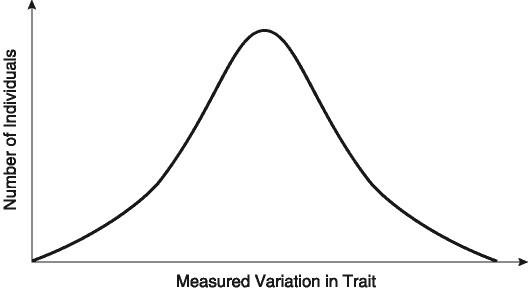
The figure below represents the fastest speed in a prey population of pikas. There is a large population of these pikas. If the curve below shifts to the right during successive generations in which no gene flow occurs. Which of the following is (are) probably occurring in the pikas? (multiple answers may be true)
Select one or more:
a. Pikas from a different population are
migrating into the area.
b. directional selection
c.
adaptation
d. genetic drift
e. disruptive selection
b. directional selection
c. adaptation
Over time, the movement of people on Earth has steadily increased.
This has altered the course of human evolution by
increasing
Select one:
a. nonrandom mating
b.
geographic isolation
c. genetic drift
d. gene flow
e. speciation
d. gene flow
Flower color in sweet pea in part comes from the pigment anthocyanin.
One step is catalyzed by an enzyme called chalcone synthase. When
chalcone synthase doesn't work at all , the flowers are white. The
normal enzyme is denoted + whereas the non-functioning enzyme is
denoted -. Heterozygotes are purple. In a particular large population
the following genotype frequencies are observed:
genotype
frequencies
Genotype Frequency
++ 0.60
+- 0.20
-- 0.20
What is the frequency of the - allele in this
population? Please enter your number as two digits after a zero and a
decimal (just like the frequencies above). If the frequency is 0.8
enter 0.80. If the frequency is 0.934 enter is as 0.93. Don't do .93.
Don't write .9.
0.30
Flower color in sweet pea in part comes from the pigment anthocyanin.
One step is catalyzed by an enzyme called chalcone synthase. When
chalcone synthase doesn't work at all , the flowers are white. The
normal enzyme is denoted + whereas the non-functioning enzyme is
denoted -. Heterozygotes are purple. In a particular large population
the following genotype frequencies are observed:
genotype
frequencies
Genotype Frequency
++ 0.60
+- 0.20
-- 0.20
What is the expected heterozygote frequency if the
population is in hardy weinberg equilibrium? Please enter your number
as two digits after a zero and a decimal (just like the frequencies
above). If the frequency is 0.8 enter 0.80. If the frequency is 0.934
enter is as 0.93. Don't do .93. Don't write .9.
0.42
Flower color in sweet pea in part comes from the pigment anthocyanin.
One step is catalyzed by an enzyme called chalcone synthase. When
chalcone synthase doesn't work at all , the flowers are white. The
normal enzyme is denoted + whereas the non-functioning enzyme is
denoted -. Heterozygotes are purple. In a particular large population
the following genotype frequencies are observed:
genotype
frequencies
Genotype Frequency
++ 0.60
+- 0.20
-- 0.20
Is this population in hardy Weinberg equilibrium?
Please note that you should use your answers to the last two questions
to help you answer this question?
Select one:
a. yes
b. no
c. there is not enough
information provided to answer this question
b. no
Which of the following pairs are the best examples of homologous
structures?
Select one:
a. owl wing and hornet wing
b.
bat wing and bird wing
c. bones in the bat wing and bones in the
human forelimb
d. eyelessness in the Australian mole and
eyelessness in the North American mole
c. bones in the bat wing and bones in the human forelimb
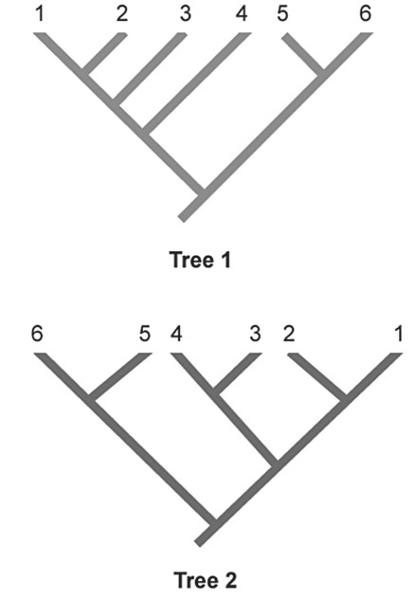
In the phylogenetic trees above, numbers represent species and the same species are shown in both trees. Which two species are represented as sister species in Tree 2 but are not shown as sister species in Tree 1?
Select one:
a. 1 and 2
b. 2 and 3
c. 3 and 4
d.
4 and 5
e. 5 and 6
c. 3 and 4
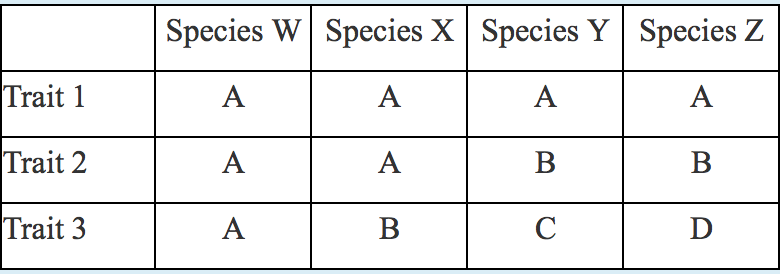
Given that phylogenies are based on shared derived characteristics, which of the following traits is useful in generating a phylogeny of species W, X, Y, and Z?
Select one:
a. trait 1
b. trait 2
c. trait
3
d. all of the traits
e. traits 2 and 3
b. trait 2
Some beetles and flies have antler-like structures on their heads,
much like male deer do. The existence of antlers in beetle, fly, and
deer species with strong male-male competition is an example of
_____.
Select one:
a. convergent evolution
b. a
synapomorphy
c. homology
d. parsimony
a. convergent evolution
In a phylogenetic tree, a node or branching point
represents:
Select one:
a. the species in the fossil record
from which the descendent species diverged.
b. one of the
descendent species in the phylogeny.
c. the ancestral species
from which all species in the phylogeny arose.
d. the common
ancestor from which the descendent species diverged.
e. A node
could be any of these, depending on the nature of the phylogenetic tree.
d. the common ancestor from which the descendent species diverged.
A taxon that does not include the last common ancestor of all its
members is a _____ group.
Select one:
a.
monophyletic
b. paraphyletic
c. polyphyletic
c. polyphyletic
Characters that are similar because of descent from a common ancestor
are _____; characters that are similar due to convergent evolution are
_____.
Select one:
a. homologous; analogous
b.
analogous; homologous
c. parsimonious, analogous
a. homologous; analogous
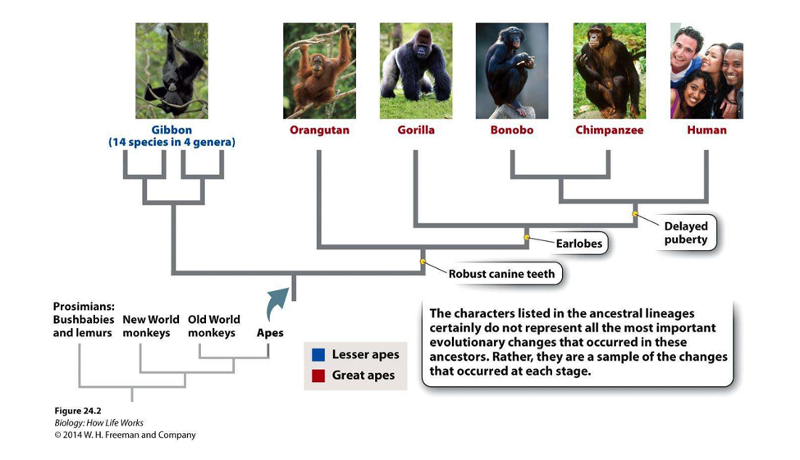
The phylogeny below shows
apes
Select one:
a.
Organgutans and gorillas are more closely related than humans and
gorillas
b. Humans and gorillas are more closely related than
orangutans and gorillas
c. The gorilla is the most recent common
ancestor of bonobos, chimps and humans
d. The orangutan is the
most recent common ancestor of all great apes.
e. All great apes
walk with an upright gait.
b. Humans and gorillas are more closely related than orangutans and gorillas
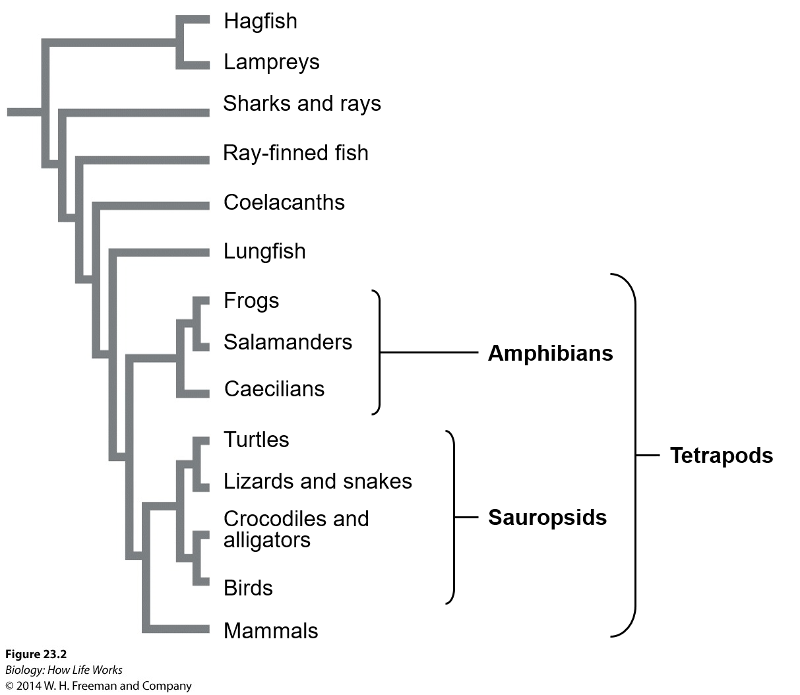
According to the figure, the group "fish" includes all
vertebrates except the tetrapods. The taxon "fish" is
therefore a ________ group.
Select one:
a.
monophyletic
b. paraphyletic
c. polyphyletic
b. paraphyletic
Which of the following factors would not contribute to allopatric
speciation?
Select one:
a. A population becomes
geographically isolated from the parent population.
b. A
population separated from the main population geographically is small,
and genetic drift occurs
c. Different mutations begin to
distinguish the gene pools of the separated populations.
d. Gene
flow between the two populations is extensive.
d. Gene flow between the two populations is extensive.
On the Bahamian island of Andros, mosquitofish populations live in
various, now-isolated, freshwater ponds that were once united.
Currently, some predator-rich ponds have mosquitofish that can swim in
short, fast bursts; other predator-poor ponds have mosquitofish that
can swim continuously for a long time. When placed together in the
same body of water, the two kinds of female mosquitofish exhibit
exclusive breeding preferences. Which type of reproductive isolation
operates to keep the mosquitofish isolated, even when fish from
different ponds are reunited in the same body of water?
Select
one:
a. behavioral isolation
b. habitat isolation
c.
temporal isolation
d. mechanical isolation
e. post-zygotic isolation
a. behavioral isolation
Bird guides once listed the myrtle warbler and Audubon's warbler as
distinct species. Recently, these birds have been classified as
eastern and western forms of a single species, the yellow-rumped
warbler. Which of the following pieces of evidence, if true, would be
cause for this reclassification?
Select one:
a. The two
forms interbreed often in nature, and their offspring have good
survival and reproduction.
b. The two forms live in similar
habitats.
c. The two forms have many genes in common.
d. The
two forms have similar food requirements.
e. The two forms are
very similar in coloration.
a. The two forms interbreed often in nature, and their offspring have good survival and reproduction.
You are maintaining a population of fruit flies in the laboratory by
transferring a quarter of the flies to a new culture bottle after each
generation. The original population was both phenotypically and
genetically diverse. After several generations, you notice that the
viability of the flies has decreased greatly. Which of the following
might combat the trend in your experiment? Choose all possible
answers.
Select one or more:
a. Raise the temperature so
that the flies go through more generations each month
b. Transfer
fewer flies each generation
c. Order some wild flies (from
flies-r-us presumably) and interbreed them with your flies
d.
Reintroduce flies from your starting population to the population (so
that they interbreed).
c. Order some wild flies (from flies-r-us presumably) and interbreed
them with your flies
d. Reintroduce flies from your starting
population to the population (so that they interbreed).
A small group of naked mole rats is isolated from the colony during a
flood. They land on an isolated island and find it to their liking,
which is a good thing because they can't get back to the mainland.
They are fruitful and they multiply, ultimately leading to a new
population on the isolated island. This population’s long term allelic
frequencies will most likely be affected by (pick all that
apply).
Select one or more:
a. founder effect
b.
Bottleneck effect
c. gene flow with the original colony
d.
genetic drift
a. founder effect
d. genetic drift
Diane Dodd took one population of fruit flies split it into two
groups. She raised one on maltose based food and the other on a starch
based food for several generations (both are stressful and the
populations took a long time to establish). At the end of the
experiment she mixed the flies to see if they would interbreed.
A scenario (not in the original experiment) the two groups of
flies were then mixed together in a new chamber with both starch and
maltose. Few hybrids flies are produced, but those that are can use
both starch and maltose and they have offspring that can also use
starch and maltose. What would the likely effect of this be?
Select one:
a. genetic drift
b. reinforcement of the
hybrid zone
c. The hybrid flies would have a selective advantage
(leading potentially to fusion of the two populations)
d. the
two groups of flies (maltose and starch) would continue to remain
separate (stability of the isolated populations)
c. The hybrid flies would have a selective advantage (leading potentially to fusion of the two populations)
Dog breeders maintain the purity of breeds by keeping dogs of
different breeds apart when they are fertile. This kind of isolation
is most similar to which of the following reproductive isolating
mechanisms?
Select one:
a. reduced hybrid fertility
b.
hybrid breakdown
c. mechanical isolation
d. habitat
isolation
e. gametic isolation
d. habitat isolation
Dogs (Canis lupus familiaris) and gray wolves (Canis lupus) can
interbreed to produce viable, fertile offspring. These species shared
a common ancestor recently (in geologic time) and have a high degree
of genetic similarity, although their anatomies vary widely. Judging
from this evidence, which two species concepts are most likely to
place dogs and wolves together into a single species?
Select
one:
a. ecological and morphological
b. ecological and
phylogenetic
c. morphological and phylogenetic
d. biological
and morphological
e. biological and phylogenetic
e. biological and phylogenetic
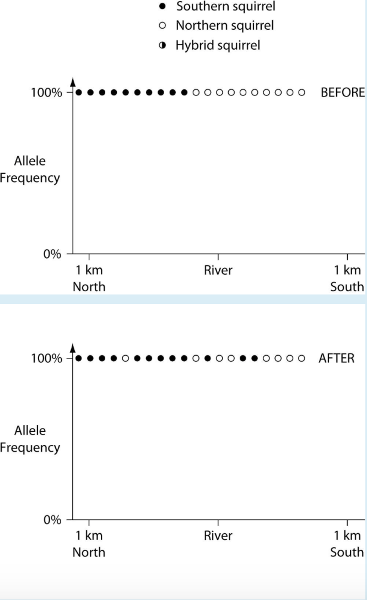
The data in the previous graphs indicate that
In a hypothetical situation, the National Park Service, which administers Grand Canyon National Park in Arizona, builds a footbridge over the Colorado River at the bottom of the canyon. The footbridge permits interspersal of two closely related antelope squirrels. Previously, one type of squirrel had been restricted to the terrain south of the river, and the other type had been restricted to terrain on the north side of the river. Immediately before and ten years after the bridge's completion, researchers collected ten antelope squirrels from both sides of the river, took blood samples, and collected frequencies of alleles unique to the two types of antelope squirrels (see the following graphs).
The data in the previous graphs indicate that
Select
one:
a. a hybrid zone was established after the completion of the
bridge.
b. no interspersal of the two types of squirrel occurred
after the completion of the bridge.
c. gene flow occurred from
one type of squirrel into the gene pool of the other type of
squirrel.
d. two-way migration of squirrels occurred across the
bridge, but without hybridization.
e. some northern squirrels
migrated south, but no southern squirrels migrated north across the bridge.
d. two-way migration of squirrels occurred across the bridge, but without hybridization.
An advantage that simple multicellular eukaryotes have over
single-celled organisms is the ability:
Select one:
a. Of
the cells in the multicellular organism to communicate with one
another.
b. Of the cells in a group of cells to avoid predation
c. For autotrophic cells in the multicellular organism to supply
heterotrophic cells with nutrients
d. To respond to the external
environmental more efficiently.
b. Of the cells in a group of cells to avoid predation
In which order were the key features of complex multicellularity
likely to have appeared?
Select one:
a. Cell adhesion, cell
communication, regulated growth and development.
b. Cell
communication, cell adhesion, regulated growth and
development.
c. Regulated growth and development, cell
communication, cell adhesion,
d. Regulated growth and
development, cell adhesion, cell communication.
a. Cell adhesion, cell communication, regulated growth and development.
Organisms that are dependent on oxygen for cellular respiration depend on which of the following processes to move oxygen into cells?
a. simple diffusion
b. active transport
c. pinocytosis
d. facilitated diffusion
a. simple diffusion
The evolution from simple multicellular organisms to complex
multicellular organisms required:
Select one:
a. an ability
to respond to the environment.
b. the development of a system
that enabled bulk transport.
c. cell-surface receptors.
b. the development of a system that enabled bulk transport.
The passive movement of a solute from a point of high concentration
to a point of low concentration is known as:
Select one:
a.
Diffusion
b. Active transport
c. Endocytosis
d. Solubility
a. Diffusion
Which of the following is characteristic of complex
multicellularity?
Select one:
a. All cells are exposed to an
exterior surface.
b. The interior cells are tolerant to lower
oxygen levels than exterior cells.
c. Interior cells are exposed
to a different physical and chemical environment than exterior cells.
d. All cells of complex multicellular organisms express the same genes.
c. Interior cells are exposed to a different physical and chemical environment than exterior cells.
Which of the following statements concerning complex multicellular
organisms is true?
Select one:
a. Plants and animals use
bulk transport systems to move gases and nutrients but fungi and algae
do not.
b. Bulk transport systems require specialized organs like
a heart to pump nutrients and dissolved gases deep into tissues that
are not in contact with the external environment.
c. Bulk
transport systems move substances faster than simple diffusion.
d. Only animals use bulk transport systems as other organisms
rely on diffusion alone.
c. Bulk transport systems move substances faster than simple diffusion.
Which of the following terms describes the process by which a
fertilized egg develops into a multicellular organism with hundreds of
different cell types, each with different structures and
functions?
Select one:
a. Adhesion
b.
Differentiation
c. Communication
d. Embryology
b. Differentiation
Which one of the following is a characteristic of complex
multicellular organisms, but not simple multicellular
organisms?
Select one:
a. the functional specialization of
subsets of cells in the organism
b. the use of cell-adhesion
molecules to allow cells to adhere to one another
c. the presence
of a single cell with multiple nuclei
d. the presence of cells
that are not in direct contact with the external environment
a. the functional specialization of subsets of cells in the organism
Which one of the following statements correctly describes features
shared by simple multicellular eukaryotes?
Select one:
a.
Cells adhere to one another; most of the cells are capable of a wide
range of functions, including reproduction; and the loss of one or
more cells usually does not lead to the death of the organism.
b.
Cells adhere to one another and engage in extensive communication with
one another; most of the cells are capable of a wide range of
functions, including reproduction; and the loss of one or more cells
usually does not lead to the death of the organism.
c. Cells
adhere to one another and most of the cells are capable of a wide
range of functions except the ability to reproduce, which means that
the loss of certain cells usually leads to the death of the organism.
a. Cells adhere to one another; most of the cells are capable of a wide range of functions, including reproduction; and the loss of one or more cells usually does not lead to the death of the organism.
Genetic and fossil evidence suggest that humans, chimps and bonobos
share a common ancestor.
Select one:
True
False
True
Beetle pollinators of a particular plant are attracted to its flowers' bright orange color. The beetles not only pollinate the flowers, but they mate while inside of the flowers. A mutant version of the plant with red flowers becomes more common with the passage of time. A particular variant of the beetle prefers the red flowers to the orange flowers. Over time, these two beetle variants diverge from each other to such an extent that interbreeding is no longer possible. What kind of speciation has occurred in this example, and what has driven it?
Select one:
a. allopatric speciation; ecological
isolation
b. sympatric speciation; habitat differentiation
c. allopatric speciation; behavioral isolation
d. sympatric
speciation; sexual selection
sympatric speciation; sexual
selection
sympatric speciation; sexual selection
e.
sympatric speciation; allopolyploidy (when two species hybridize
creating a polyploid hybrid)
b. sympatric speciation; habitat differentiation
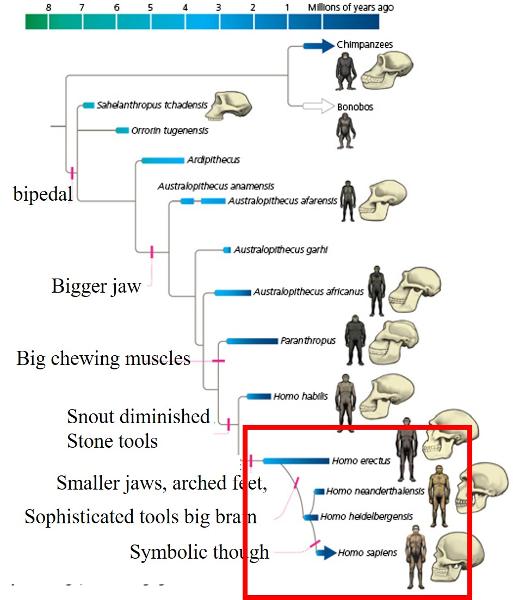
For the indicated group which is an ancestral trait?
Select one or more:
a. bipedal
b. big chewing
muscles
c. bigger jaw
d. smaller jaws, arched feet
e.
sophisticated tool use
f. symbolic thought
a. bipedal
c. bigger jaw
Please match the words with the defintion.
1.characters that are
similar because of descent from a common ancestor
are(homologous/analogous)
2.characters that are similar due to
convergent evolution are(homologous/analogous)
1. Homologous
2. Analogous
A taxon that does not include the last common ancestor of all its
members is a _____ group.
Select one:
a. paraphyletic
b. polyphyletic
c. monophyletic
b. polyphyletic
Which of the following pairs are the best examples of homologous
structures?
Select one:
a. bones in the bat wing and bones
in the human forelimb
b. owl wing and hornet wing
c. bat
wing and bird wing
d. eyelessness in the Australian mole and
eyelessness in the North American mole
a. bones in the bat wing and bones in the human forelimb
Some molecular data place the giant panda in the bear family
(Ursidae) but place the lesser panda in the raccoon family
(Procyonidae). Consequently, if these data are correct the
morphological similarities of these two species (giant and lesser
panda) are probably due to
Select one:
a. inheritance of
acquired characteristics.
b. stabilizing selection
c.
inheritance of shared derived characters.
d. possession of
analogous structures.
e. possession of shared ancestral characters.
d. possession of analogous structures.
The Lemurs, tarsiers and bush babies are different from other
primates because they are the same as the ancestral species that led
to the anthropoids.
Select one:
True
False
False
Which of the following are true statements?
a. The concept of the missing link between humans and our ape like ancestors is flawed because there is no single organism that will bridge the gap, there are many transitional organisms, and fossils are exceedingly rare.
b. monkeys are a polyphyletic group
c. apes are a paraphyletic group because humans are not included
d. The phylogenetic tree of primates is constructed from both morphological and genetic data
a. The concept of the missing link between humans and our ape like ancestors is flawed because there is no single organism that will bridge the gap, there are many transitional organisms, and fossils are exceedingly rare.
d. The phylogenetic tree of primates is constructed from both morphological and genetic data
Place the following hierarchical genes in the order that they are
turned on in drosophila larval development.
Maternal co-ordinate
genes
Gap genes
Pair-Rule genes
Segment polarity
genes
Hox genes
1
2
3
4
5
In Arabidopsis, the floral meristem is organized into four concentric
whorls of cells, each of which gives rise to a specific organ of the
mature flower. The floral meristem is therefore analogous to what
cells or tissues in animals?
Select one:
a. totipotent stem
cells
b. cells in the morula
c. the inner cell mass of the
blastula
d. the germ layers of the gastrula
e. None of these
choices are correct
e. None of these choices are correct
As a transcription factor, Pax6:
Select one:
a. targets the
approximately 2000 genes needed for eye development.
b. activates
its target genes.
c. represses its target genes.
d.
activates some target genes and represses others.
d. activates some target genes and represses others.
Evolutionarily conserved molecules:
Select one:
a. are
similar in sequence among distantly related organisms.
b. were
likely present in the most recent common ancestor of the organisms
possessing them.
c. likely changed little over time because they
serve a vital function.
d. are similar in sequence among
distantly related organisms and were likely present in their most
recent common ancestor.
e. are similar in sequence among
distantly related organisms, were likely present in their most recent
common ancestor, and have likely changed very little because they
serve a vital function.
e. are similar in sequence among distantly related organisms, were likely present in their most recent common ancestor, and have likely changed very little because they serve a vital function.
Gene regulation during development is _____, which means that
_____.
Select one:
a. restrictive; genes are successively
lost over time
b. restrictive; genes lose developmental potential
over time
c. hierarchical; genes expressed at each stage control
the expression of genes that act later
d. hierarchical; genes
are turned on in a specific sequence, starting with totipotent and
ending with multipotent
e. combinatorial; genes expressed at each
stage control the expression of genes that act later
c. hierarchical; genes expressed at each stage control the expression of genes that act later
Gurdons nuclear transplantation experiments with clawed toads
supported the hypothesis that
Select one:
a. differentiation
is the result of genes being successively deleted from the
genome.
b. differentiation is the result of genes being
successively turned off.
c. differentiation causes cells to
become pluripotent.
d. only nuclei from the blastocyst retain
sufficient potency to produce an adult organism.
e. All of these
choices are correct.
b. differentiation is the result of genes being successively turned off.
In almost all organisms that have been studied, the genes in Hox
clusters:
Select one:
a. are arranged on chromosomes in the
same order as their products function along the anterior-posterior
segments of the embryo.
b. are expressed in a sequence that is
independent of their linear organization along the chromosome.
c.
each contain a unique homeodomain, the products of which are very
different among organisms.
d. are arranged on the chromosomes in
a sequence that is independent of the order in which their products
function along the anterior-posterior axis of the embryo.
e. None
of these choices are correct.
a. are arranged on chromosomes in the same order as their products function along the anterior-posterior segments of the embryo.
In mammals, Hox genes:
Select one:
a. specify limbs and
other structures associated with each body segment.
b. direct
development of structures that become parts of the hindbrain, spinal
cord, and vertebral column.
c. evolved by partial-genome
duplication from the ancestral genes.
d. are expressed in a
sequence that does not reflect their linear order on the chromosome or
the regions they affect.
e. All of these choices are correct.
b. direct development of structures that become parts of the hindbrain, spinal cord, and vertebral column.
Maternal-effect genes:
Select one:
a. are expressed by the
mother.
b. affect maternal phenotype.
c. affect offspring
phenotype.
d. are expressed by the mother and affect maternal
phenotype.
e. are expressed by the mother and affect offspring phenotype.
e. are expressed by the mother and affect offspring phenotype.
Use figure 20.6 to answer this question, An abnormal Drosophila larva
that is missing much of its posterior end is likely deficient in
_______ function.
Select one:
a. Bicoid
b.
Nanos
c. Hunchback
b. Nanos
Which of the following correctly orders the sequence in which genes
controlling the development of the anterior-posterior axis of
Drosophila larvae are expressed?
Select one:
a.
Maternal-effect genes, gap genes, pair-rule genes, segment-polarity
genes
b. Maternal-effect genes, gap genes, segment-polarity
genes, pair-rule genes.
c. Pair-rule genes, maternal-effect
genes, segment-polarity genes, gap genes.
d. Maternal-effect
genes, segment-polarity genes, pair-rule genes, gap genes.
e. Gap
genes, pair-rule genes, segment-polarity genes, maternal-effect genes.
a. Maternal-effect genes, gap genes, pair-rule genes, segment-polarity genes
Which of the following lists cell types in order from those capable
of differentiating into the greatest number of different specialized
cells to those capable of differentiating into the least number of
different specialized cells?
Select one:
a. multipotent,
pluripotent, totipotent
b. pluripotent, totipotent,
multipotent
c. totipotent, multipotent, pluripotent
d.
totipotent, pluripotent, multipotent
e. multipotent, totipotent, pluripotent
Feedback
d. totipotent, pluripotent, multipotent
Using figure 20.6 to answer this question. If a Drosophila larva is missing much of its anterior end, it is likely due to a mutation in the ____________.
Select one:
a. Maternal bicoid gene
b. Zygotic bicoid
gene
c. Maternal nanos gene
d. zygotic nanos gene
a. Maternal bicoid gene
Which of the following are commonalities between prokaryotes and
eukaryotes.
Select one or more:
a. basic metabolic pathways
(e.g. glycolysis)
b. they both use DNA and RNA
c. They have
membranes
d. Both types of cells have a nucleus
e. They both
have evolved multicellularity several times.
a. basic metabolic pathways (e.g. glycolysis)
b. they both use
DNA and RNA
c. They have membranes
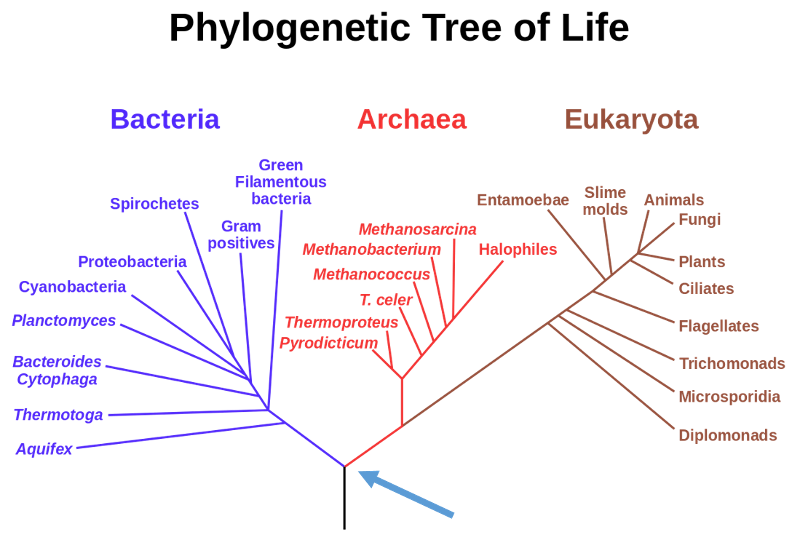
What do scientists call the hypothesized organism at the node indicated?
LUCA
What is the main limitation on cell size?
Select one:
a.
diffusion
b. bulk transport
c. oxygen
d. cell membrane strength
a. diffusion
Which one of the following is a selective advantage of simple
multicellularity over single-celled organisms?
Select
one:
a. Multicellularity helps organisms avoid predation.
b. Mutlicellularity results in fundamental changes in metabolic
processes
c. Multicellularity helps organisms utilize more food
sources compared to say bacteria.
d. Multicellularity helps
organisms enhance efficiency of reproduction.
a. Multicellularity helps organisms avoid predation.
Which of the following best describes a morphogen?
Select
one:
a. a cell that secretes diffusible signaling molecules that
play a role in specifying cell fate
b. a diffusible signaling
molecule that plays a role in specifying cell fate during embryonic
development
c. a protein that helps mediate direct cell-cell
interaction
d. a protein that enables cells to become totipotent
(totipotent cells can develop into any other cell in the organism).
b. a diffusible signaling molecule that plays a role in specifying cell fate during embryonic development

In class I showed you in example of snowflake yeast. Yeast were selected for settling (essentially heaviness) over several generations. Results of the experiment is shown below. Based on this as well as what we discussed in class, in what ways are these lab created "organisms" like a multicellular organism?
Select one or more:
a. They have specialized cells and
tissues.
b. They have a mechanism of cell to cell adhesion.
c. They control the size of the organism by regulating cell
size.
d. They have specialized reproductive cells that handle
the transfer of genetic information.
e. They're creepy.
b. They have a mechanism of cell to cell adhesion.
c. They
control the size of the organism by regulating cell size.
In class we looked at an experiment in which human glial progenitor
cells were implanted in a newborn mouse's brain. If the mice with the
implanted glial cells were allowed to have offspring, would these
offspring have a competitive advantage? That is would the smarter mice
pass the trait on to their pups?
Select one:
a. No
b. Yes
a. No
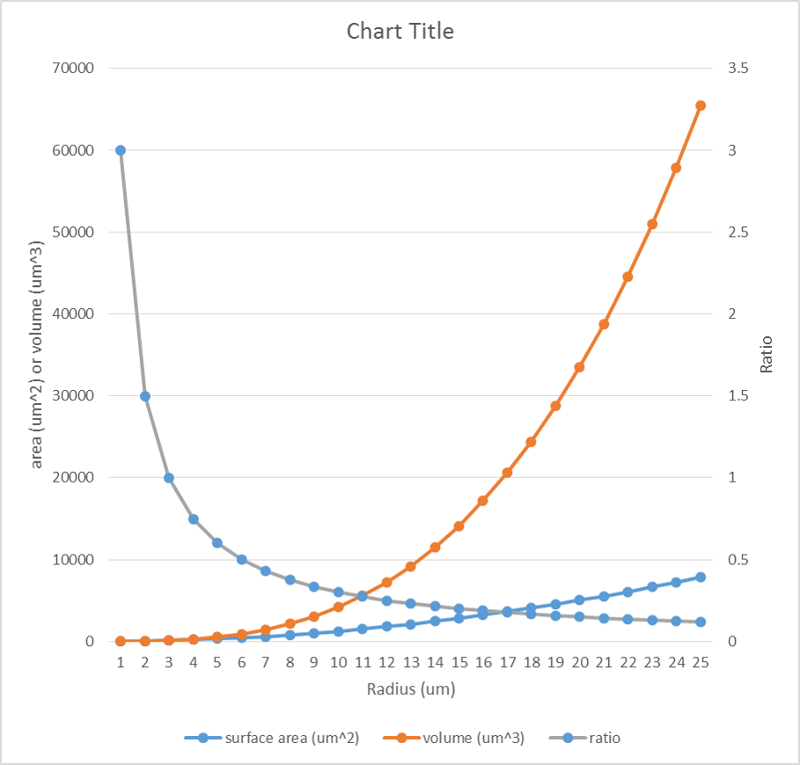
At what part of the X-axis scale does the surface area to volume RATIO change most dramatically?
Select one:
a.
For small cells (radius <5 um)
b.
For large cells (radius >20 um)
c.
For medium
sized cells (radius 10-15)
d.
It’s a continuous rate of change
a.
For small cells (radius <5 um)
In fruit flies, maternal-effect gene mRNA (pick all that are
true)
Select one or more:
a. are transcribed by the mother
b. alter the maternal phenotype
c. affect offspring phenotype
a. are transcribed by the mother
c. affect offspring phenotype
As cells become differentiated, they delete the DNA for genes they no
longer need.
Select one:
True
False
False
A drosophila larva that is knocked out (it's totally non functional)
for a pair rule gene is most likely to
Select one:
a. lack
the entire posterior or anterior end of the larva
b. lack a large
section of the larva (several adjacent segments)
c. lack every
other segment
d. have segments that are mirror images (lack a
front and back)
e. have body parts in the wrong place
c. lack every other segment
Pores on the leaf surface that function in gas exchange are
called
Select one:
a. hairs.
b. xylem cells.
c.
phloem cells.
d. stomata.
e. sclereids.
d. stomata.
Stomata are key sites of information processing because ____________.
(Select all correct answer options.)
Select one or more:
a.
they respond to CO2 demand
b. they respond to H2O loss
c.
they open in response to O2
d. they open in response to light
a. they respond to CO2 demand
b. they respond to H2O loss
The opening of stomata is thought to involve
Select one:
a.
an increase in the solute concentration of the guard cells.
b. a
decrease in the solute concentration of the stoma.
c. active
transport of water out of the guard cells.
d. decreased turgor
pressure in guard cells.
e. movement of K+ from the guard cells.
a. an increase in the solute concentration of the guard cells.
What is the main force by which most of the water within xylem
vessels moves toward the top of a tree?
Select one:
a.
active transport of ions into the root stele
b. atmospheric
pressure on roots
c. evaporation of water through stoma
d.
the force of root pressure
e. osmosis in the root
c. evaporation of water through stoma
If water molecules (H2O) suddenly stopped forming hydrogen bonds with
one another, how would water transport in vascular plants change (if
at all)?
Select one:
a. It would remain the same, as H2O
molecules also form oxygen bonds.
b. It would remain the same, as
water transport only depends on osmosis.
c. It would stop, as
water transport relies on H2O molecules being connected by hydrogen
bonds.
d. It would increase, as hydrogen bonds inhibit water transport.
c. It would stop, as water transport relies on H2O molecules being connected by hydrogen bonds.
Which of the following is a correct statement about sugar movement in
phloem?
Select one:
a. Diffusion can account for the
observed rates of transport.
b. Movement can occur both upward
and downward in the plant.
c. Sugar is translocated from sinks to
sources.
d. Only phloem cells with nuclei can perform sugar
movement.
e. Sugar transport does not require energy.
b. Movement can occur both upward and downward in the plant.
Phloem transport of sucrose is often described as going from source
to sink. Which of the following would not normally function as a
sink?
Select one:
a. growing leaf
b. growing
root
c. storage organ in summer
d. mature leaf
e.
shoot tip
d. mature leaf
What is typically the result of double fertilization in
angiosperms?
Select one:
a. The endosperm develops into a
diploid nutrient tissue.
b. A triploid zygote is formed.
c.
Both a diploid embryo and triploid endosperm are formed.
d. Two
embryos develop in every seed.
e. The antipodal cells develop
into the seed coat.
c. Both a diploid embryo and triploid endosperm are formed.
Which of the following is a correct sequence of processes that takes
place when a flowering plant reproduces? Use figure 30.17
Select
one:
a. meiosis --> fertilization --> ovulation -->
germination
b. fertilization--> meiosis --> nuclear fusion
--> formation of embryo and endosperm
c. meiosis -->
pollination --> nuclear fusion--> formation of embryo and
endosperm
d. growth of pollen tube --> pollination-->
germination--> fertilization
e. meiosis --> mitosis -->
nuclear fusion --> pollen
c. meiosis --> pollination --> nuclear fusion--> formation of embryo and endosperm
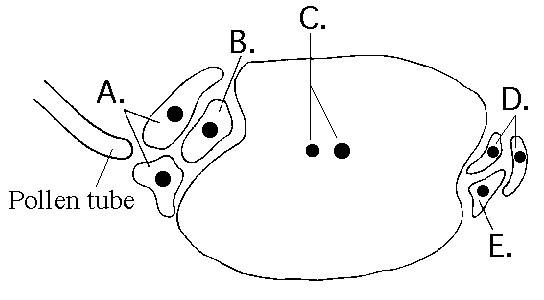
Based on the figure below, which cell(s), after fertilization,
give(s) rise to the embryo plant?
h
Select one:
a.
A
b. B
c. C
d. D
e. E
b. B
A drosophila larva that is knocked out (it's totally non functional)
for a pair rule gene is most likely to
Select one:
a. lack
the entire posterior or anterior end of the larva
b. lack a large
section of the larva (several adjacent segments)
c. lack every
other segment
d. have segments that are mirror images (lack a
front and back)
e. have body parts in the wrong place
c. lack every other segment
Which of the following best describes a morphogen?
Select
one:
a. a cell that secretes diffusible signaling molecules that
play a role in specifying cell fate
b. a diffusible signaling
molecule that plays a role in specifying cell fate during embryonic
development
c. a protein that helps mediate direct cell-cell
interaction
d. a protein that enables cells to become totipotent
(totipotent cells can develop into any other cell in the organism).
b. a diffusible signaling molecule that plays a role in specifying cell fate during embryonic development
When a gene is expressed at the wrong time or place in an organism it is called
ectopic
In fruit flies, maternal-effect gene mRNA (pick all that are
true)
Select one or more:
a. are transcribed by the mother
b. alter the maternal phenotype
c. affect offspring
phenotype
d. are translated by the mother
e. are translated
by the offspring
a. are transcribed by the mother
c. affect offspring phenotype
e. are translated by the offspring
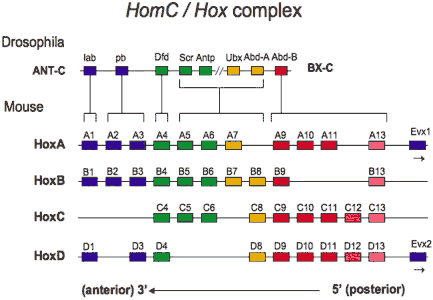
Given your understanding of Hox genes in animal development which of the following would be a reasonable consequence of knocking out expression of the D10-D13 genes on mouse development (you may also find it helpful to look at the slides from class).
Select one:
a. Mice with legs where they should have
tails
b. Mouse embryos with deformities on the posterior part of
their bodies
c. Mouse embryos with deformities on the anterior
part of their bodies.
d. There would be unlikely to be any
consequences as the other Hox genes with the same ordinal value (e.g.
C10-C13) will compensate
e. The 2R hypothesis suggests that only
one cluster is functional, the others are the result of a genome duplication.
b. Mouse embryos with deformities on the posterior part of their bodies
Mouse and human pax-6 share 100% sequence identity (they have the
same sequence of amino acids). Given the fact that mice and humans
have different eyes, how can this be true?
Select one:
a.
Pax6 is expressed earlier in development in the mouse
b. Pax6 is
a transcription factor and the genes it activates in mice and humans
are different leading to different eyes.
c. Pax6 mRNA is spliced
differently in humans and mice
d. Expression level is critical
for function and it is expressed at a much higher level in
humans
e. All of the above are possible
b. Pax6 is a transcription factor and the genes it activates in mice and humans are different leading to different eyes.
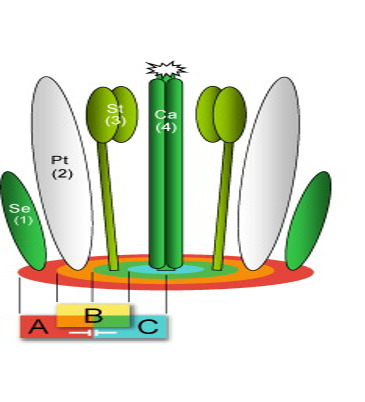
According to the ABC hypothesis about combinatorial control of floral morphogenesis, what would the unattractive flower below look like if you knocked out C function genes?
Select one:
a. It would be all sepals
b. Petals in
whorls 2 and 3 and sepals in the first and fourth whorl
c. It would have two whorls of sepals and two whorls of
carpels
d. It would go sepals on the outside petals on the
inside
e. It would just be missing the carpel
b. Petals in whorls 2 and 3 and sepals in the first and fourth whorl
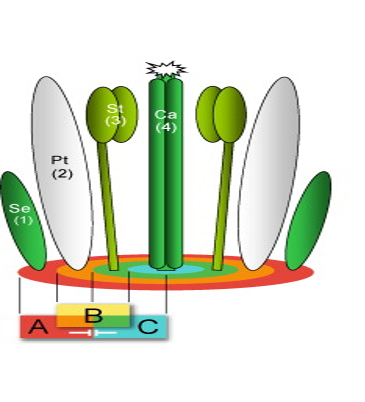
According to the ABC hypothesis about combinatorial control of floral morphogenesis, what would the unattractive flower below look like if you knocked out B function genes according to the ABC hypothesis for floral development?
Select one:
a. It would be all sepals
b. It would
have one whorl of sepals and three whorls of carpels
c. It
would have two whorls of sepals and two whorls of carpels
d. It would be all petals
e. It would just be
missing the petals
c. It would have two whorls of sepals and two whorls of carpels
Which of the following are true?
Select one or more:
a.
Xylem cell walls are under negative pressure.
b. When stomates
are closed the force that moves water through the xylem stops.
c.
If one were to inhibit sugar transport out of leaf cells by blocking
ATP synthesis, phloem transport would stop.
d. In the fall, the
liquid in the xylem runs from the leaves (sources) to the roots
(sinks) to store sugar for the next spring.
e. Blocking guard
cell function would directly inhibit phloem function.
b. When stomates are closed the force that moves water through the
xylem stops.
c. If one were to inhibit sugar transport out of
leaf cells by blocking ATP synthesis, phloem transport would stop
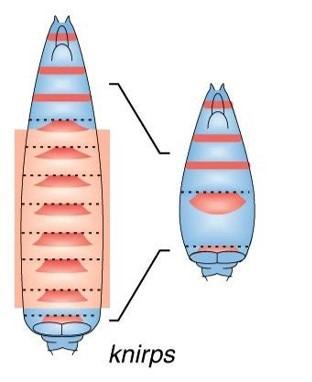
The image below shows a wild type embryo (left) and a mutant embryo (right). The mutant is missing all of the segments in the shaded box, but the remaining segments look normal. A gene at which level of developmental hierarchy is probably mutated?
adfa
Select one:
a. Maternal effect genes
b. pair
rule genes
c. segment polarity genes
d. hox genes
e.
gap genes
e. gap genes
Which of the following statements is true regarding respiration in
birds?
Select one:
a. Bird lungs inflate due to negative
pressure in the chest cavity.
b. Bird lungs deflate due to
negative pressure in the chest cavity.
c. Oxygen enters the
bloodstream via crosscurrent exchange.
d. Oxygen enters the
bloodstream via countercurrent exchange.
e. Respiration depends
on the movement of air through spiracles.
c. Oxygen enters the bloodstream via crosscurrent exchange.
In the heart of a fish, where would you expect to find oxygenated
blood? (look at fig. 39.19 carefully )
Select one:
a. in the
right atrium
b. in the left atrium
c. in the
ventricle
d. in a single atrium (fish only have
one)
e.Nowhere; oxygenated blood does not pass through a fish’s heart.
e.Nowhere; oxygenated blood does not pass through a fish’s heart.
Circulatory systems have the primary benefit of overcoming the
shortcomings of
Select one:
a. temperature differences
between the lungs and the active tissue.
b. the slow rate at
which diffusion occurs across cells.
c. communication systems
involving only the nervous system.
d. having to cushion animals
from trauma.
e. fetal organisms maintaining an optimal body temperature.
b. the slow rate at which diffusion occurs across cells.
Countercurrent exchange in the fish gill helps to
maximize
Select one:
a. endocytosis.
b. blood
pressure.
c. diffusion.
d. active transport.
e. osmosis.
c. diffusion.
If the partial pressure of oxygen (pO2) in a man’s blood plasma decreased below that in his red blood cells, what would be the result?
Select one:
a. More oxygen would diffuse into his red blood
cells and be transported throughout his body.
b. Oxygen would
diffuse out of his red blood cells, and less oxygen would be
transported throughout his body.
c. The concentration of oxygen
would be the same in red blood cells and blood plasma.
b. Oxygen would diffuse out of his red blood cells, and less oxygen would be transported throughout his body.
Much of the fluid that moves across capillary walls and into the
tissues moves as a result of filtration, forced by blood pressure. O2
on the other hand travels from the capillaries into the
tissues:
Select one:
a. because of a concentration gradient
between O2 in the tissues and O2 in the blood.
b. because of
high CO2 concentration in the tissues, created as a by-product of
cellular respiration.
c. because osmotic pressure causes a net
flow of O2 from the tissues into the blood.
d. because it is
pumped into the tissues where it is needed.
a. because of a concentration gradient between O2 in the tissues and O2 in the blood.
One of the functions of the respiratory system is to rid the body of
CO2. Where does the CO2 come from?
Select one:
a. CO2 is a
breakdown product of the carbohydrates oxidized in cellular
respiration.
b. CO2 is a breakdown product of the carbohydrates
reduced in cellular respiration.
c. CO2 is produced when inhaled
oxygen combines with carbon atoms from carbohydrates.
d. CO2 is
produced when the oxygen atoms of water combine with carbon atoms.
a. CO2 is a breakdown product of the carbohydrates oxidized in cellular respiration.
The set of blood vessels with the lowest blood pressure driving flow
is
Select one:
a. the arteries.
b. the
arterioles.
c. the metarterioles.
d. the
capillaries.
e. the veins.
e. the veins.
Which of the following is the correct sequence of blood flow in
reptiles and mammals?
Select one:
a. left ventricle -->
aorta ---> lungs --> systemic circulation
b. right
ventricle --> pulmonary vein --> pulmocutaneous
circulation
c. pulmonary vein --> left atrium -->left
ventricle --> pulmonary circuit
d. vena cava --> right
atrium --> right ventricle --> pulmonary circuit
e. right
atrium --> pulmonary artery --> left atrium --> ventricle
d. vena cava --> right atrium --> right ventricle --> pulmonary circuit
Which of the following types of blood vessels would have the greatest
resistance to flow?
Select one:
a. veins
b.
capillaries
c. venules
d. arteries
e. arterioles
b. capillaries
In the heart of a reptile or amphibian, where would you expect to
find oxygenated blood? Select all correct choices.
Select one or
more:
a. in the right atrium
b. in the left atrium
c.
mixed with de-oxygenated blood in a common ventricle
d. mixed
with de-oxygenated blood in the right ventricle
e. Nowhere;
oxygenated blood does not travel through the heart of these animals.
b. in the left atrium
c. mixed with de-oxygenated blood in a
common ventricle
If water passed over the gills of fish in the same direction as blood
flow through the capillaries in lamellae, how would gas exchange be
affected? Select all correct choices.
Select one or more:
a.
Gas exchange would remain the same, regardless of the direction of
water flow.
b. More oxygen would diffuse from the water into the
fish’s bloodstream.
c. Less oxygen would diffuse from the water
into the fish’s bloodstream.
d. More carbon dioxide would
diffuse out of the fish’s bloodstream into the water.
e. Less
carbon dioxide would diffuse out of the fish’s bloodstream into the water.
c. Less oxygen would diffuse from the water into the fish’s bloodstream.
In a mammal’s bloodstream, where would you expect to find
oxygen?
Select one:
a. attached to the heme group of
myoblobin in red blood cells
b. attached to the heme groups of
hemoglobin in red blood cells
c. attached to the heme group of
myosin in red blood cells
d. dissolved in hemolymph
Feedback
b. attached to the heme groups of hemoglobin in red blood cells
Decide whether each structure is a source or a sink with regards to
phloem. Sugar maples are what is used to make maple syrup. They are
tapped in March to withdraw the sap which is then boiled down to make
syrup. (Source or Sink)
1. A leaf on a maple tree in June
2. A bud on a maple tree in early spring
3. A tomato fruit as it is turning red
4. The roots of a sugar maple tree in early spring
5. The roots of a sugar maple tree in fall
1. source
2. sink
3. sink
4. source
5. sink
If you were to place a dried apricot into a beaker full of water and
another dried apricot into a beaker full of apricot juice (which is
very sugary), which apricot would swell the most?
Select
one:
a. Apricot in water
b. Apricot in apricot
juice
c. They both would swell the same amount.
a. Apricot in water
CO2 enters the inner spaces of the leaf through the
Select
one:
a. cuticle
b. epidermal trichomes
c. stomata
d. phloem
e. guard cells
c. stomata
A tomato fruit should be.
Select one:
a. triploid
b.
diploid
c. haploid
d. polypoloid
b. diploid
Which of the following is an angiosperm female
gametophyte?
Select one:
a. polar cells which will become
the endosperm when they fuse with a sperm nuclei
b. The
egg
c. The embryo sac
d. the pollen
e. the pollen
sperm nucleus
c. The embryo sac
In vascular plants, water transport in xylem only works if
___________ (more than one answer possible).
Select one or
more:
a. roots are able to generate turgor pressure
b. the
water column is continuous between leaves and soil
c. H2O
evaporates from leaves
d. xylem and phloem are in close proximity
b. the water column is continuous between leaves and soil
c.
H2O evaporates from leaves
The body's automatic tendency to maintain a constant and optimal
internal environment is termed
Select one:
a. balanced
equilibrium.
b. physiological chance.
c.
homeostasis.
d. static equilibrium.
e. estivation
c. homeostasis.
After the depolarization phase of an action potential, the resting
potential is restored by
Select one:
a. the opening of
sodium activation channels.
b. the opening of voltage-gated
potassium channels and the closing of sodium channels.
c. a
decrease in the membrane's permeability to potassium and chloride
ions.
d. a brief inhibition of the sodium-potassium pump.
e.
the opening of more voltage-gated sodium channels.
b. the opening of voltage-gated potassium channels and the closing of sodium channels.
Immediately after an action potential passes along an axon, it is not
possible to generate a second action potential; thus, we state that
the membrane is briefly
Select one:
a.
hyperexcitable.
b. refractory.
c. fully
depolarized.
d. above threshold.
e. at the equilibrium potential.
b. refractory.
In a simple synapse, neurotransmitter chemicals are released
by
Select one:
a. the dendritic membrane.
b. the
presynaptic membrane.
c. axon hillocks.
d. cell
bodies.
e. ducts on the smooth endoplasmic reticulum.
b. the presynaptic membrane.
In the sequence of permeability changes for a complete action
potential, the first of these events that occurs is
Select
one:
a. the activation of the sodium-potassium
"pump."
b. the inhibition of the sodium-potassium
"pump."
c. the opening of voltage-gated sodium
channels.
d. the closing of voltage-gated potassium
channels.
e. the opening of voltage-gated potassium channels.
c. the opening of voltage-gated sodium channels.
Neural transmission across a mammalian synaptic gap is accomplished
by
Select one:
a. the movement of sodium and potassium ions
from the presynaptic neuron into the postsynaptic neuron.
b.
impulses traveling as electrical currents across the gap.
c.
impulses causing the release of a chemical signal and its diffusion
across the gap.
d. impulses ricocheting back and forth across the
gap.
e. the movement of calcium ions from the presynaptic into
the postsynaptic neuron.
c. impulses causing the release of a chemical signal and its diffusion across the gap.
Opening all of the sodium channels, with all other ion channels
closed (which is an admittedly artificial setting) on an otherwise
typical neuron should move its membrane potential to
Select
one:
a. -90 mV.
b. -70 mV.
c. 0 mV.
d. +30
mV.
e. +62 mV.
e. +62 mV.
The "threshold" potential of a membrane
Select
one:
a. is the point of separation from a living to a dead
neuron.
b. is the lowest frequency of action potentials a neuron
can produce.
c. is the minimum hyperpolarization needed to
prevent the occurrence of action potentials.
d. is the minimum
depolarization needed to operate the voltage-gated sodium and
potassium channels.
e. is the peak amount of depolarization seen
in an action potential.
d. is the minimum depolarization needed to operate the voltage-gated sodium and potassium channels.
The fastest possible conduction velocity of action potentials is
observed in
Select one:
a. thin, non-myelinated
neurons.
b. thin, myelinated neurons.
c. thick,
non-myelinated neurons.
d. thick, myelinated neurons.
d. thick, myelinated neurons.
The nucleus and most of the organelles in a neuron are located in
the
Select one:
a. dendritic region.
b. axon
hillock.
c. axon.
d. cell body.
e. axon terminals.
d. cell body.
The operation of the sodium-potassium "pump"
moves
Select one:
a. sodium and potassium ions into the
cell.
b. sodium and potassium ions out of the cell.
c.
sodium ions into the cell and potassium ions out of the cell.
d.
sodium ions out of the cell and potassium ions into the cell.
e.
sodium and potassium ions into the mitochondria.
d. sodium ions out of the cell and potassium ions into the cell.
The point of connection between two communicating neurons is
called
Select one:
a. the axon hillock.
b. the
dendrite.
c. the synapse.
d. the cell body.
e. the glia.
c. the synapse.
Consider the energy budgets for a human, an elephant, a penguin, a
mouse (10 g), and a snake (100 g). The ________ would have the highest
total annual energy expenditure, and the ________ would have the
highest energy expenditure per unit mass.
Select one:
a.
elephant; mouse
b. elephant; human
c. human;
penguin
d. mouse; snake
e. penguin; mouse
a. elephant; mouse
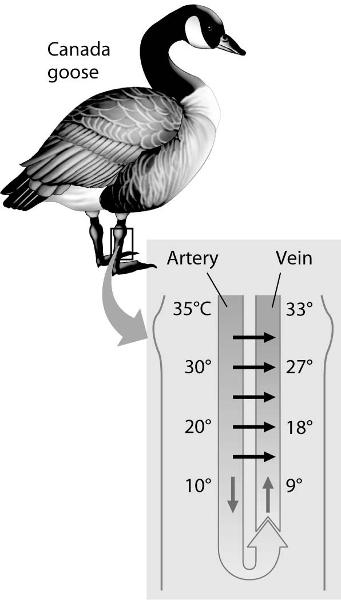
The thin horizontal arrows in the figure below show that
Select one:
a. the warmer arterial blood can bypass the legs as
needed, when the legs are too cold to function well.
b. the
warmer venous blood transfers heat to the cooler arterial
blood
c. the warmer arterial blood transfers heat to the cooler
venous blood, so body heat is not lost through the feet.
d. the
arterial blood is always cooler in the abdomen, compared to the
temperature of the venous blood in the feet of the goose.
e. the
goose's legs get progressively warmer as the blood moves away from the
abdomen to the feet.
c. the warmer arterial blood transfers heat to the cooler venous blood, so body heat is not lost through the feet.
The body's automatic tendency to maintain a constant and optimal
internal environment is termed
Select one:
a. balanced
equilibrium.
b. physiological chance.
c. homeostasis.
d. static equilibrium.
e. estivation
c. homeostasis.
When the temperature of the outside air exceeds their internal body
temperature, jackrabbits living in hot, arid lands will. Think about
how energy transfer works before answering.
Select one:
a.
dilate (make larger diameter) the blood vessels in their large ears to
transfer move heat from the blood to the environment.
b.
constrict (make smaller diameter) the blood vessels in their large
ears to reduce transfer of external heat from their ears to their
bodies and seek shade.
c. increase motor movements to find a
sunny area to maximize heat transfer into their bodies.
d.
increase pigmentation in their ears, darkening them to maximize their
capacity to take up heat.
e. begin involuntary shivering of their
skeletal muscles in order to generate more metabolic heat.
b. constrict (make smaller diameter) the blood vessels in their large ears to reduce transfer of external heat from their ears to their bodies and seek shade.
African elephants use their ears to dissipate body heat. To aid in
this process they flap their ears, and stand in the shade when the
ambient air is hotter than their body temperature. Which of the
following is true about this behavior?
Select one or
more:
a. The elephants will dilate the blood vessels leading to
and in the ears so that more blood will flow through them so as to
increase heat loss to the environment.
b. A counter-current heat
exchange blood vessel system runs to their ears.
c. The elephants
lose heat from their ears to the environment through convection (when
flapping) and radiation
d. The elephants will constrict the blood
vessels to their ears so that the blood flows through more rapidly,
thus dissipating heat better.
e. Ear flapping is not an example
of a behavioral control of body heat because it only lowers
temperature and cannot raise it.
a. The elephants will dilate the blood vessels leading to and in the ears so that more blood will flow through them so as to increase heat loss to the environment.
c. The elephants lose heat from their ears to the environment through convection (when flapping) and radiation
The Q10 of a system is. Careful now, choose the best definition.
Select one:
a. The change in the reaction rate when the
temperature is increased 10 degrees Celsius.
b. Describes how
the reaction rate doubles for every 10 degrees you change the reaction
conditions for enzymes.
c. Only really meaningful in
endotherms
d. Is meant to show that when you increase the
temperature 2 degrees, the reaction rate should go up 10X
e. None
of the above
a. The change in the reaction rate when the temperature is increased 10 degrees Celsius.
Which of the following are true of homeostatically controlled
systems?
Select one or more:
a. Homeostatically controlled
systems only occur in endotherms because they maintain a static
temperature.
b. The value of the homeostatically controlled
variable will oscillate up and down around a set point.
c. They
use negative feedback to maintain dynamic constancy.
d. Can
include homeostatic control of pH, ion concentration and sugar levels
in blood in addition to temperature.
e. Unicellular organisms
cannot exhibit homeostasis because they do not exhibit behavior.
b. The value of the homeostatically controlled variable will
oscillate up and down around a set point.
c. They use negative
feedback to maintain dynamic constancy.
d. Can include
homeostatic control of pH, ion concentration and sugar levels in blood
in addition to temperature.
Humans can lose, but cannot gain, heat through
Select
one:
a. conduction
b. convection
c. radiation
d.
evaporation
e. metabolism
d. evaporation
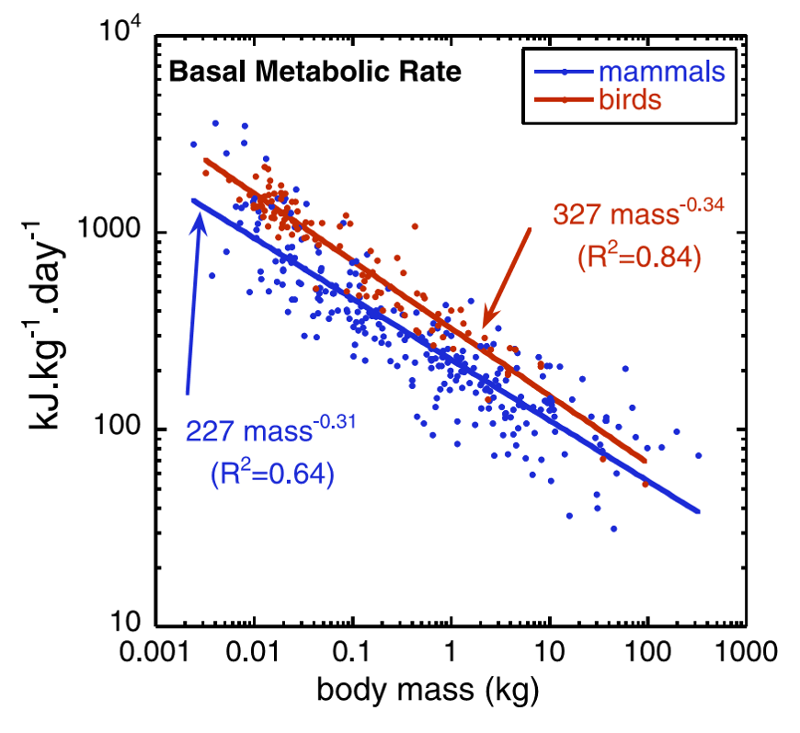
The data in the chart below suggest that
d
Select one or more:
a. In general a bird of the same
mass as a mammal will use slightly more energy per unit weight per day
(compare the trend lines not individual data points).
b. Smaller
birds and mammals need more food per unit mass
c. Large mammals
are less efficient at converting food to energy.
d. Large animals
use less energy than small animals because they have a higher surface
to volume ratio.
a. In general a bird of the same mass as a mammal will use slightly
more energy per unit weight per day (compare the trend lines not
individual data points).
b. Smaller birds and mammals need more
food per unit mass
A skeletal muscle deprived of adequate ATP supplies will
Select
one:
a. immediately relax.
b. release all actin-myosin
bonds.
c. enter a state where actin and myosin are unable to
separate.
d. fire many more action potentials than usual and
enter a state of "rigor."
e. sequester all free calcium
ions into the sarcoplasmic reticulum.
c. enter a state where actin and myosin are unable to separate.
An endoskeleton is the primary body support for the
Select
one:
a. annelids, including earthworms.
b. insects,
including beetles.
c. cartilaginous fishes, including
sharks.
d. bivalves, including clams.
e. crustaceans,
including lobsters.
c. cartilaginous fishes, including sharks.
Compared to oxidative skeletal muscle fibers, those classified as
glycolytic typically have
Select one:
a. a higher
concentration of myoglobin.
b. a higher density of
mitochondria.
c. a darker visual appearance.
d. a smaller
diameter.
e. less resistance to fatigue.
e. less resistance to fatigue.
In a relaxed skeletal muscle, actin is not chemically bound
to
Select one:
a. myosin.
b. troponin.
c.
tropomyosin.
d. Z lines
a. myosin.
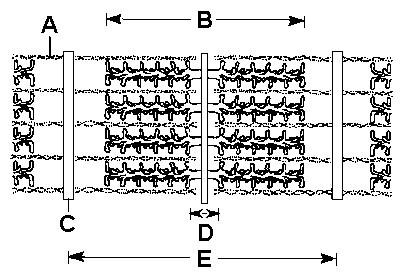
Myosin filaments without actin overlap are in which section of the
figure?
Select one:
a. A
b. B
c. C
d. D
d. D
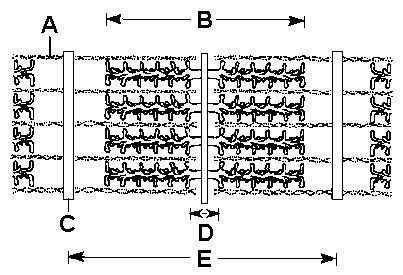
Overlapping actin and myosin filaments are found in which section of
the figure?
Select one:
a. A
b. B
c. C
d. D
e. E
b. B
The contraction of skeletal muscles is based on
Select
one:
a. actin filaments coiling up to become shorter.
b.
myosin filaments coiling up to become shorter.
c. actin and
myosin filaments both coiling up to become shorter.
d. actin
cross-bridges binding to myosin and then flexing.
e. myosin
cross-bridges binding to actin and then flexing.
e. myosin cross-bridges binding to actin and then flexing.
What event results from the hydrolysis of ATP to ADP by the myosin
head?
Select one:
a. cross-bridge formation
b.
shortening of the muscle fiber
c. cocking of myosin head to its
high-energy position
d. the power stroke
c. cocking of myosin head to its high-energy position
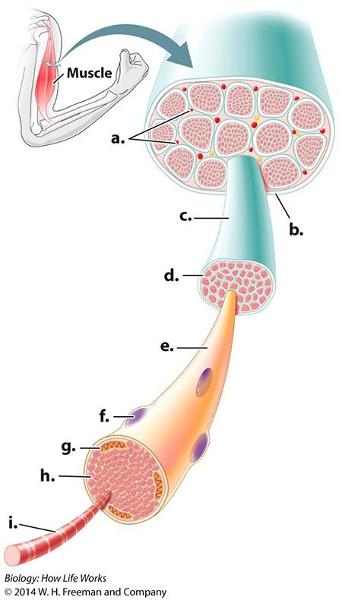
Which letter(s) in the diagram of a muscle refer(s) to an individual muscle cell?
Select one:
a. A
b. B
c. C
d. D
e. E
f. F
g. G
h. H
i. I
e. E
Muscles that contract slowly and use less ATP to generate their force
contain primarily:
Select one:
a. small motor units
b.
fast twitch fibers
c. slow twitch fibers
d. obtain their
every primarily through anaerobic glycolytic processes
c. slow twitch fibers
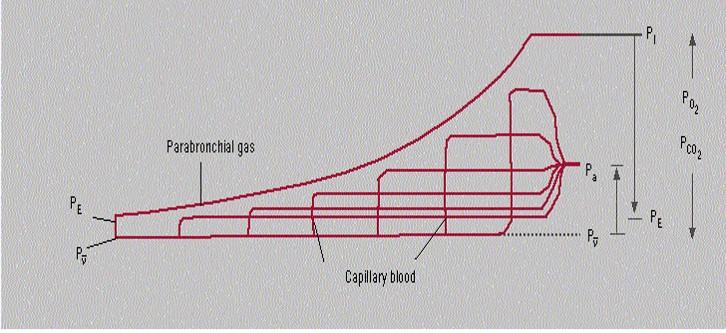
The diagram below represents oxygen exchange in an avian lung. The line at the top represents the flow of air through the lung. Pi represents the partial oxygen pressure of the inhaled air and Pe is the pO2 of the exhaled air (so it goes from right to left). The blood flow is represented by the network of lines below. Pv represents the pO2 of the depleted air coming to the lung (usually called venous but technically arterial). Pa represents the pO2 of the oxygenated blood (again for technical reasons it's venous but called arterial in this diagram). Each of the lines going up from the bottom represents a capillary as it gains oxygen. Indicate which of the following statements are correct using this diagram and knowledge from lecture/reading/elsewhere.
Select one or more:
a. The blood leaving the lung has a higher
p02 than the air leaving the lung.
b. Avian lungs use a
countercurrent method of gas exchange.
c. At the right end of
the diagram the pO2 in the arteries is essentially an average of the
compined pO2 of the capillaries because all of the capillaries leave
in a single blood vessel to the heart
d. avian lungs use a
crosscurrent method of gas exchange
e. The pCO2 should be higher
in the Pi than the Pe
a. The blood leaving the lung has a higher p02 than the air leaving the lung.
c. At the right end of the diagram the pO2 in the arteries is essentially an average of the compined pO2 of the capillaries because all of the capillaries leave in a single blood vessel to the heart
d. avian lungs use a crosscurrent method of gas exchange
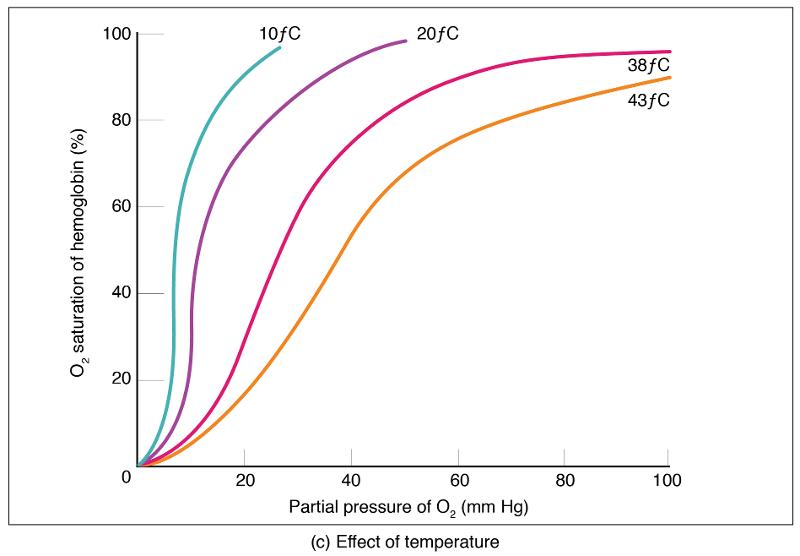
The graph below shows the percent saturation for hemoglobin at various temperatures given different partial pressures of oxygen. Most tissues at rest have a pO2 of ~40 mm Hg. If the hemoglobin delivering oxygen to these tissues was at 10 degrees C, what would be the consequence
Select one:
a. The tissues would easily strip the hemoglobin of
oxygen so that the organism can function
b. The tissues would be
oxygen starved because the hemoglobin is saturated at that
pO2.
c. The tissues would unload oxygen to the hemoglobin so that
it would lower its saturation
d. You cannot answer this question
with the information given.
b. The tissues would be oxygen starved because the hemoglobin is saturated at that pO2.
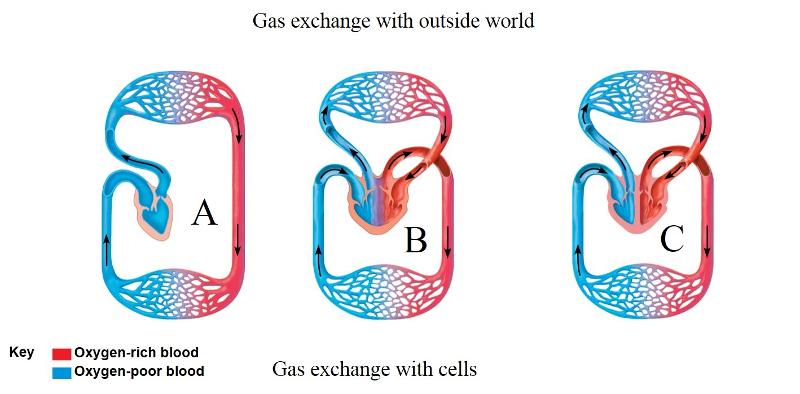
If we assume that the blood leaving the "gas exchange with outside world" capillary bed is all at the same pO2 (not the case in the real world), which of these systems would have the lowest pO2 in the "gas exchange with cells" capillary beds? Remember to think about the advantages/disadvantages of the two, three and four chambered hearts.
Select one:
a. A
b. B
c. C
d. They would all be
the same
e. It is impossible to tell from the information given.
b. B
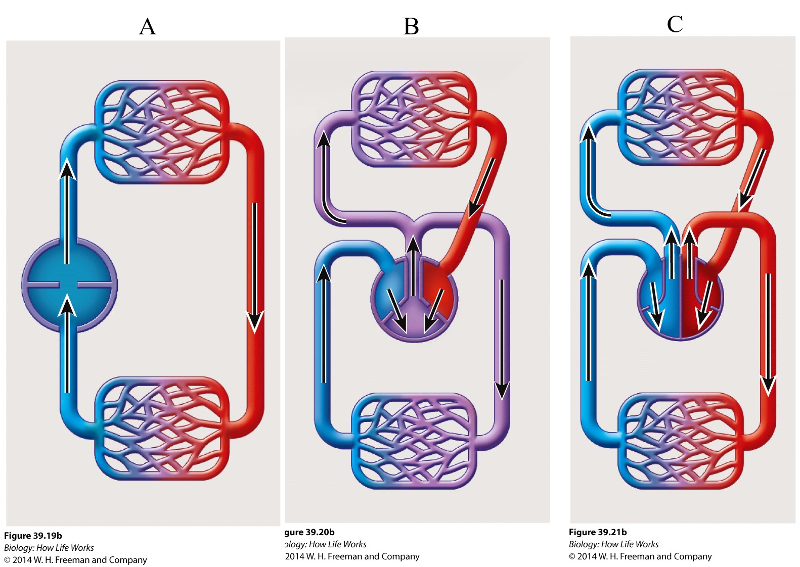
Which of the following can control the pressure of the pulmonary and
systemic capillary beds separately?
Select one:
a. A
b. B
c. C
d. A, B
e.
B,C
f. A, C
g. A, B, C
h. None of them can
c. C
Neural transmission across a mammalian synaptic gap is accomplished
by
Select one:
a. the movement of sodium and potassium ions
from the presynaptic neuron into the postsynaptic neuron.
b.
impulses traveling as electrical currents across the gap.
c.
impulses causing the release of a chemical signal and its diffusion
across the gap.
d. impulses ricocheting back and forth across the
gap.
e. the movement of calcium ions from the presynaptic into
the postsynaptic neuron.
c. impulses causing the release of a chemical signal and its diffusion across the gap.
The nucleus and most of the organelles in a neuron are located in
the
Select one:
a. dendritic region.
b. axon
hillock.
c. axon.
d. cell body.
e. axon terminals.
d. cell body.
If a cell normally has an intracellular concentration of 200 mM K+
and an extracellular concentration of 9 mM K+ what would happen to the
membrane potential if you artificially raise the external
concentration to 60 mM. Assume that the membrane is highly permeable
to K+ and much less so to other ions. (you may find that the nernst
goldman application linked in the quiz header) Open the app, choose
Nernst and click on K+. Now set the intra and extra-cellular potassium
amounts either by sliding the sliders or just clicking and entering
the numbers. Then change the extracellular and observe how the
membrane potential alters.
Select one:
a. the membrane
potential will become more positive
b. the membrane potential
will become more negative
c. the nernst potential will become
more negative
d. the membrane potential will remain the same
a. the membrane potential will become more positive
The Nernst potential, or equilibrium potential can be calculated with
the following formula
E=62mV(log Co/Ci)
where Co represents
concentration outside of the cell and Ci represents concentration in
the cell.
What is the Nernst potential for a cell that has 200 mM
K+ inside and 10 mM K+ outside
(just answer the number, round up
to a whole number and no units) -- the units are mV.
You may find
the nernst/goldman application helpful, but remember the nernst
equation I'm giving you is for 37 degrees not room temperature.
-81
A population is correctly defined as having which of the following
characteristics?
I. live and reproduce in the same general
area
II. belonging to the same species
III. possessing a
constant and uniform density and dispersion
Select one:
a. I only
b. III only
c. I and II only
d. II and III only
e. I, II and III
c. I and II only
An ecologist recorded 12 white-tailed deer, Odocoileus virginianus,
per square mile in one woodlot and 20 per square mile in another
woodlot. What was the ecologist comparing?
Select one:
a.
density
b. dispersion
c. carrying capacity
d.
cohorts
e. range
a. density
Which of the following choices would most likely promote random
distribution?
Select one:
a. territorial species
b.
species that secrete chemicals to attract or inhibit other
individuals
c. flocking and schooling behaviros
d. spacing
during the breeding season
e. homogeneous chemical and physical
factors in the environment
e. homogeneous chemical and physical factors in the environment
Consider two forests: one is an undisturbed old-growth forest, while
the other has recently been logged. In which forest are species likely
to experience exponential growth, and why?
Select one:
a.
Old growth, because of stable conditions that would favor exponential
growth of all species in the forest.
b. Old growth, because each
of the species is well established and can produce many
offspring.
c. Logged, because the disturbed forest affords more
resources for increased specific populations to grow.
d. Logged,
because the various populations are stimulated to a higher
reproductive potential.
e. Exponential growth is equally probable
in old-growth and logged forests.
c. Logged, because the disturbed forest affords more resources for increased specific populations to grow.
Which of the following causes populations to shift most quickly from
an exponential to a logistic population growth?
Select
one:
a. increased birth rate
b. removal of predators
c.
decreased death rate
d. competition for resources
e.
favorable climatic conditions
d. competition for resources
Which of the following is characteristic of
K-strategists?
Select one:
a. Have offspring with good
chances of survival
b. Have many offspring per reproductive
episode
c. Have small offspring
d. Have a high intrinsic
growth rate
e. Early parental reproduction
a. Have offspring with good chances of survival
Which of the following is most likely to contribute to
density-dependent regulation of populations?
Select one:
a.
the removal of toxic waste by decomposers
b. intra-specific
competition for nutrients
c. floods
d. fires
b. intra-specific competition for nutrients
Why do populations grow more slowly as they approach their carrying
capacity?
Select one:
a. Density-dependent factors lead to
fewer births and increased mortality.
b. Density-independent
factors lead to fewer births and increased mortality.
c. Hormonal
changes promote higher death rates in crowded populations.
d.
Individuals voluntarily stop mating so that overcrowding does not
occur.
e. The incoming energy decreases in populations
experiencing a high rate of increase.
a. Density-dependent factors lead to fewer births and increased mortality.
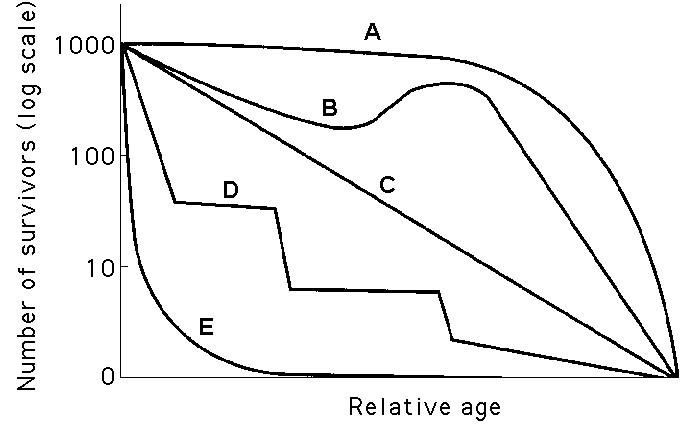
Which curve below best describes survivorship in small mammals?
Select one:
a. A
b. B
c. C
d. D
e. E
c. C
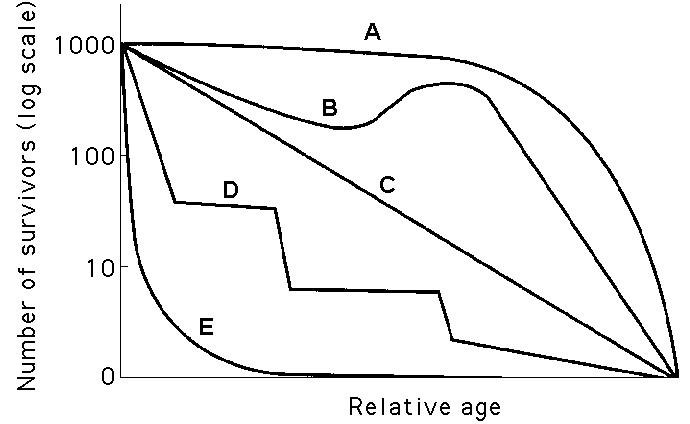
Which curve best describes survivorship in a sparrow (a small
bird)
Select one:
a. A
b. B
c. C
d.
D
e. E
c. C

Which population(s) is (are) in the process of increasing?
Select one:
a. I
b. II
c. III
d. I and
II
e. I and III
f. I, II, and III
a. I
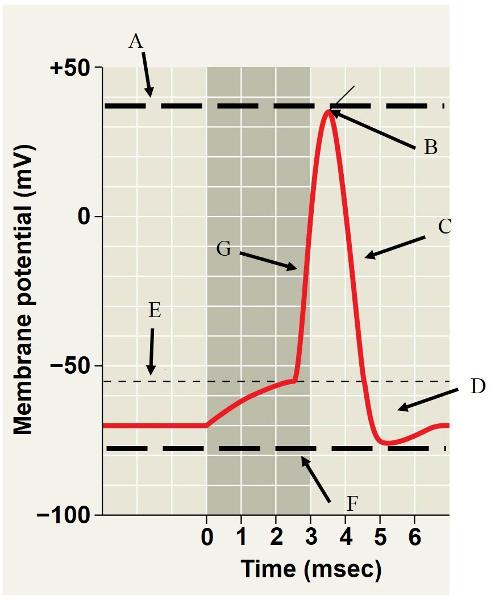
Match the letter to the event/potential
1. Na+ nernst potential
2. K+ nernst potential
3, threshold potential
4. Voltage gated sodium channels are open
5. Voltage gated potassium channels are open
1. a
2. f
3. e
4. g
5. c
After the depolarization phase of an action potential, the resting
potential is restored by
Select one:
a. the opening of
sodium activation channels.
b. the opening of voltage-gated
potassium channels and the closing of sodium channels.
c. a
decrease in the membrane's permeability to potassium and chloride
ions.
d. a brief inhibition of the sodium-potassium pump.
e.
the opening of more voltage-gated sodium channels.
b. the opening of voltage-gated potassium channels and the closing of sodium channels.
For a neuron with an initial membrane potential at -70 mV, an
increase in the movement of sodium ions into that neuron's cytoplasm
would result in the _____.
Select one:
a. depolarization of
the neuron
b. hyperpolarization of the neuron
c.
replacement of potassium ions with sodium ions
d. replacement of
potassium ions with calcium ions
e. neuron switching on its
sodium-potassium pump to restore the initial conditions
a. depolarization of the neuron
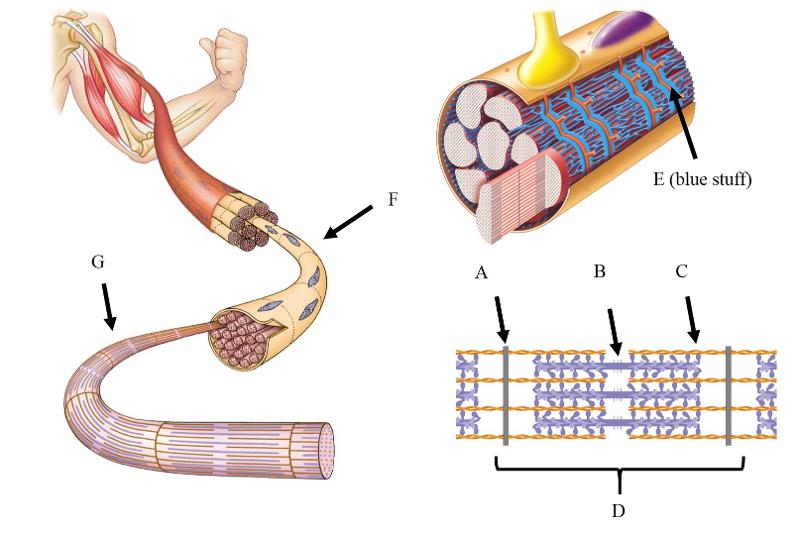
1. Z-line made of alpha-actinin
2. myosin
3. actin
4. thin filament
5. thick filament
6. sarcoplasmic reticulum
7. muscle fiber
8. myofibril
9. sarcomere
1. a
2. b
3. c
4. c
5. b
6. e
7.f
8. g
9. d
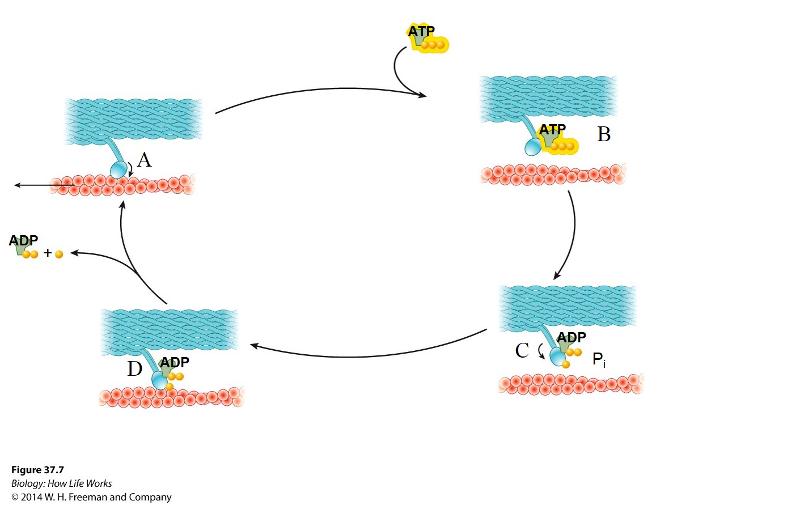
At which step does mysoin have the lowest affinity for (least likely to be bound to) actin?
Select one:
a. Step A
b. Step B
c. Step C
d.
Step D
b. Step B
AMP-PNP is a non-hydrolyzable analog of ATP that can be used in the
lab (it is not synthesized by organisms). Myosin can bind AMP-PNP, but
it does not become ADP + Pi. If you were to use this instead of ATP in
the glycerated rabbit muscle experiment we saw in class what results
would you expect (assume you add a huge concentration of AMP-PNP so
that any residual ATP in the tissue is insignificant)?
Select
one:
a. The muscles would contract but couldn't relax.
b.
the muscles would be unable to relax (as in rigor mortis)
c. The
muscles cells would contract as usual, but that would be unable to do
it again.
d. The muscles cells would relax, but would not be able
to contract.
e. they myosin would do a power stroke without
attaching to actin
d. The muscles cells would relax, but would not be able to contract.
If you were to add a cation ionophore (a chemical that allows
positive ions to diffuse freely across a membrane) to a neuron, which
of the following would be true? (more than one answer
possible)
Select one or more:
a. The membrane potential
would become more negative because more K+ could cross
b. The
action potential would get to a more positive depolarization because
more Na+ can move across the membrane.
c. The membrane potential
would disappear as the ions equilibrated across the membrane.
d.
The cell would not be able to depolarize.
e. The cell would not
be able to initiate an action potential (depolarize)
c. The membrane potential would disappear as the ions equilibrated across the membrane.
e. The cell would not be able to initiate an action potential (depolarize)
According to the competitive exclusion principle, two species cannot
continue to occupy the same
Select one:
a. habitat.
b.
niche.
c. territory.
d. range.
e. biome.
b. niche.
Approximately how many kg of carnivore biomass can be supported by a
field plot containing 1,000 kg of plant material?
Select
one:
a. 10,000
b. 1,000
c. 100
d. 10
e. 1
d. 10
Because energy transfer is not 100% efficient across trohpic levels,
a maximum of about ______% of energy and biomass available at one
trophic level is available at the next
Select one:
a.
1
b. 5
c. 10
d. 15
e. 20
c. 10
Elephants are not the most dominant species in African grasslands,
yet they influence community structure. The grasslands contain
scattered woody plants, but they are kept in check by the uprooting
activities of the elephants. Take away the elephants, and the
grasslands convert to forests or to shrublands. The newly growing
forests support fewer species than the previous grasslands. Which of
the following describes why elephants are the keystone species in this
scenario?
Select one:
a. Essentially all of the other
species depend on the presence of the elephants to maintain the
community.
b. Grazing animals depend upon the elephants to
convert forests to grassland.
c. Elephants prevent drought in
African grasslands.
d. Elephants are the biggest herbivore in
this community.
e. Elephants help other populations survive by
keeping out many of the large African predators.
a. Essentially all of the other species depend on the presence of the elephants to maintain the community.
In a pond, tadpoles eat algae and fish eat the tadpoles. Above the
pond, grasshoppers eat grass and, at night, are preyed upon by bats.
Other bats eat the fish that eat the tadpoles. In this community, the
algae are:
Select one:
a. Primary producers
b. Primary
consumers
c. Secondary consumers
d. Tertiary
consumers
e. Detrivores
a. Primary producers
In a tide pool, 15 species of invertebrates were reduced to eight
after one species was removed. The species removed was likely
a(n)
Select one:
a. pathogen.
b. keystone species.
c. herbivore.
d. resource partitioner.
e. mutualistic organism.
b. keystone species.
Resource partitioning would be most likely to occur
between
Select one:
a. sympatric populations of a predator
and its prey.
b. sympatric populations of species with similar
ecological niches.
c. sympatric populations of a flowering plant
and its specialized insect pollinator.
d. allopatric populations
of the same animal species.
e. allopatric populations of species
with similar ecological niches.
b. sympatric populations of species with similar ecological niches.
Which of the following best describes resource
partitioning?
Select one:
a. competitive exclusion that
results in the success of the superior species
b. slight
variations in niche that allow similar species to coexist
c. two
species that can coevolve to share identical niches
d.
differential resource utilization that results in a decrease in
community species diversity
e. a climax community that is reached
when no new niches are available
b. slight variations in niche that allow similar species to coexist
Which of the following terms is used by ecologists to describe the
community interaction where one organism makes the environment more
suitable for another organism?
Select one:
a.
parasitism
b. mutualism
c. inhibition
d. facilitation
e. commensalism
d. facilitation
White-breasted nuthatches and Downy woodpeckers both eat insects that
hide in the furrows of bark in hardwood trees. The Downy woodpecker
searches for insects by hunting from the bottom of the tree trunk to
the top, whereas the white-breasted nuthatch searches from the top of
the trunk down. These hunting behaviors best illustrate which of the
following ecological concepts?
Select one:
a. competitive
exclusion
b. resource partitioning
c. character
displacement
d. keystone species
e. bottom-up and top-down hypotheses
b. resource partitioning
Why are food chains relatively short?
Select one:
a.
Top-level feeders tend to be more numerous than lower-trophic-level
species.
b. Top-level feeders tend to be small but are capable of
conserving more energy.
c. Longer chains are less stable and
energy transfer between levels is inefficient.
d. There are only
so many organisms that are adapted to feed on other types of
organisms.
e. Food chain length is ultimately determined by the
photosynthetic efficiency of producers.
c. Longer chains are less stable and energy transfer between levels is inefficient.
As N approaches K for a certain population, which of the following is
predicted by the logistic equation?
Select one:
a. The
growth rate will not change.
b. The growth rate will approach
zero.
c. The growth rate will increase
d. The population
will increase exponentially.
e. The carrying capacity of the
environment will increase.
b. The growth rate will approach zero.
A population of ground squirrels has an annual per capita birth rate
of 0.06 and an annual per capita death rate of 0.02. Calculate an
estimate of the number of individuals added to a population of 1,000
individuals in one year (so that is the growth of the
population.
Select one:
a. 120
b. 40
c.
20
d. 400
b. 40

Which of the following statements are true about the age structure pyramids for China shown below.
Select one or more:
a. In 1980 if trends had continued the
population would have begun negative growth.
b. The data from
2010 suggests that the population should begin to experience negative
growth.
c. Each couple in 1980 was probably only having 2
children.
d. By 2010 couples were probably having fewer than 2
children on average.
b. The data from 2010 suggests that the population should begin to experience negative growth.
d. By 2010 couples were probably having fewer than 2 children on average.
Which of the following statements is consistent with the principle of
competitive exclusion?
Select one:
a. Bird species generally
do not compete for nesting sites.
b. The random distribution of
one competing species will have a positive impact on the population
growth of the other competing species.
c. Two species with the
same fundamental niche will exclude other competing species.
d.
Even a slight reproductive advantage will eventually lead to the
elimination of the less well adapted of two competing species.
e. Natural selection tends to increase competition between
related species.
d. Even a slight reproductive advantage will eventually lead to the elimination of the less well adapted of two competing species.
Which of the following are density dependent limits on the population
growth of a field mouse species?
Select one or more:
a.
drought (not enough rain)
b. Kitty cats
c. communicable
diseases
d. forest fire
b. Kitty cats
c. communicable diseases
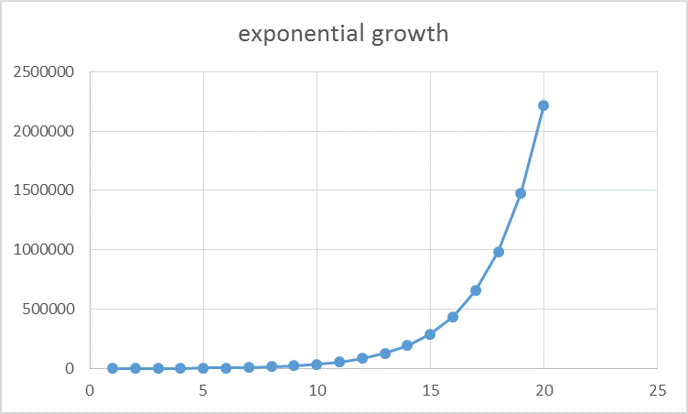
The curve below shows the growth rate of a population that has a per
capita growth rate of 0.4. Which of the following is true about this
curve. More than one is possible.
Select one or more:
a. r
becomes greater as the population grows because there are more births
per year.
b. There are more births per generation as you move
right on the graph
c. exponential growth is most often observed
in stable populations that have resided in an environment for a long
time.
d. The slope of the curve changes continuously as you move
to the right even though r remains the same
b. There are more births per generation as you move right on the graph
d. The slope of the curve changes continuously as you move to the right even though r remains the same
Glacier Bay in Alaska is a fjord whose lowlands were covered by
glacial ice until around 230 years ago. As the glacier retreated,
glacial till was exposed to plant colonization; remarkably (and
fortunately for generations of ecologists), the location of the tip of
the retreating glacier has been frequently documented since the late
1700’s. One of the first species to colonize a newly exposed area of
glacial till is fireweed. Many of its seeds will fall on rock and be
unable to germinate, but some will find purchase, few of these will
reach reproductive maturity. Which terms most appropriately
characterizes fireweed?
Select one:
a. K-strategist
b.
r-strategist
c. keystone species
d. dominant species
b. r-strategist
An ecologist recorded 12 white-tailed deer, Odocoileus virginianus,
per square mile in one woodlot and 20 per square mile in another
woodlot. What was the ecologist comparing?
Select one:
a.
density
b. dispersion
c. carry capacity
d. per capita
growth rate
e. range
a. density
In the Sierra Nevada Mountains of California there are many
populations of the checkerspot butterfly Euphydryas editha. You notice
that females of one population lay their eggs near the tip of a
plant’s stem (population A). Females of another population in the same
area lay their eggs at the base of the stem on a different type of
plant (population B). The young hatch out as caterpillars; they live
on the host plant and eat its leaves.
Select one:
a. reduced
competition through resource partitioning
b. reduced competition
through competitive exlusion
c. increased speciation rate through
resource partitioning
d. decreased speciation rate through
resource partitioning
e. a larger niche in their natural environment
a. reduced competition through resource partitioning
How might an ecologist test whether a species is occupying its
realized or its fundamental niche?
Select one:
a. Study the
temperature range and humidity requirements of the species.
b.
Observe if the niche size changes after the addition of nutritional
resources to the habitat.
c. Observe if the niche size changes
after the introduction of a similar non-native species.
d.
Measure the change in reproductive success when the species is
subjected to environmental stress.
e.Remove a competitor species
to see if the species expands its range.
e.Remove a competitor species to see if the species expands its range.
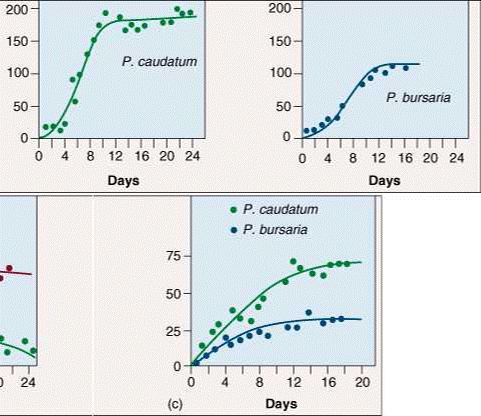
In the experiment we talked about in class two paramecium species were grown individually (top) or separately (bottom). Which of the following are true statements regarding these data?
Select one or more:
a. K for P. bursaria when grown on its own
is ~110 (individuals/mL)
b. Grown on its own both paramecium
species show logistic growth
c. P. bursaria grows more slowly
when the organisms are grown together because of competitive exclusion
d. Grown together the species have partitioned the food
resources of the flask and so never reach the same population density
e. The growth shown in the last experiment is an example of commensalism
a. K for P. bursaria when grown on its own is ~110 (individuals/mL)
b. Grown on its own both paramecium species show logistic growth
d. Grown together the species have partitioned the food resources of the flask and so never reach the same population density
Recall that sedimentary rocks, living organisms, oceans, and soil are
all carbon reservoirs. If the carbon in each of these reservoirs was
instantly transformed into atmospheric CO2, which reservoir would
contribute the most CO2 to the CO2 atmosphere?
Select
one:
a. sedimentary rocks
b. living organisms
c.
oceans
d. soil
a. sedimentary rocks
What can Antarctic ice core samples tell us about atmospheric CO2
levels? Select all that apply.
Select one or more:
a.
Nothing―ice is made of H2O and not CO2.
b. CO2 ice core data
confirms CO2 measurements taken directly from the atmosphere.
c.
Ice cores can help scientists estimate atmospheric CO2 levels from
centuries ago.
d. Ice cores can tell scientists exactly what
plants lived on Earth centuries ago.
b. CO2 ice core data confirms CO2 measurements taken directly from
the atmosphere.
c. Ice cores can help scientists estimate
atmospheric CO2 levels from centuries ago.
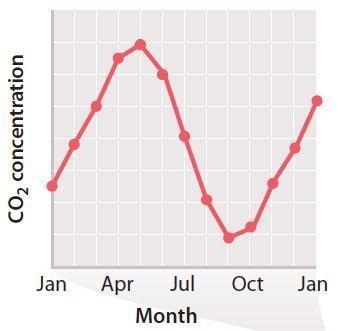
As shown in the figure below, atmospheric CO2 levels oscillate over the course of the year.Which biological process accounts for maximum CO2 levels observed in spring (May) and for lowest CO2 levels observed in fall (September)?
monthly co2
Select one:
a. photosynthesis
b. animal
respiration
c. weathering of inorganic materials
a. photosynthesis
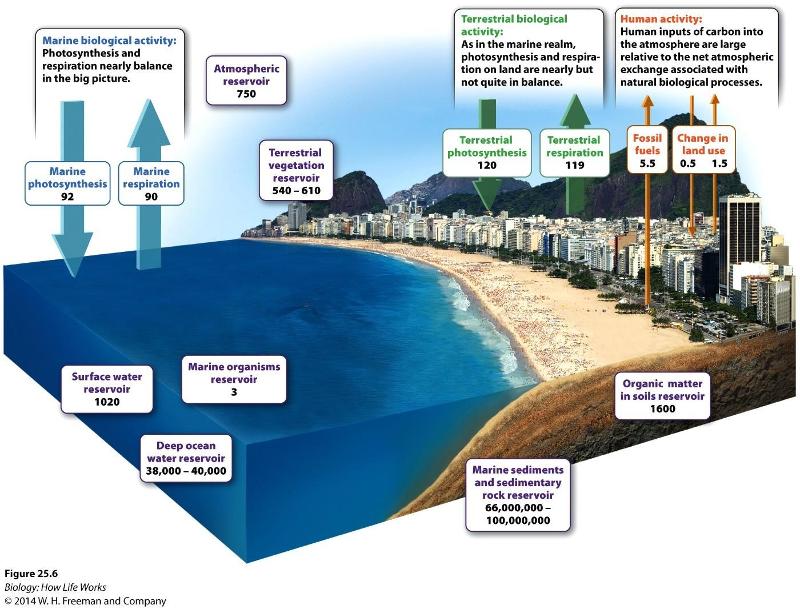
Order the carbon reservoirs in the list below from smallest to largest:
1.atmosphere
2.terrestrial vegetation
3.surface water
4.deep oceans
5.organic matter in soil
6.sedimentary rock
1. 2
2. 1
3. 3
4. 5
5. 4
6. 6
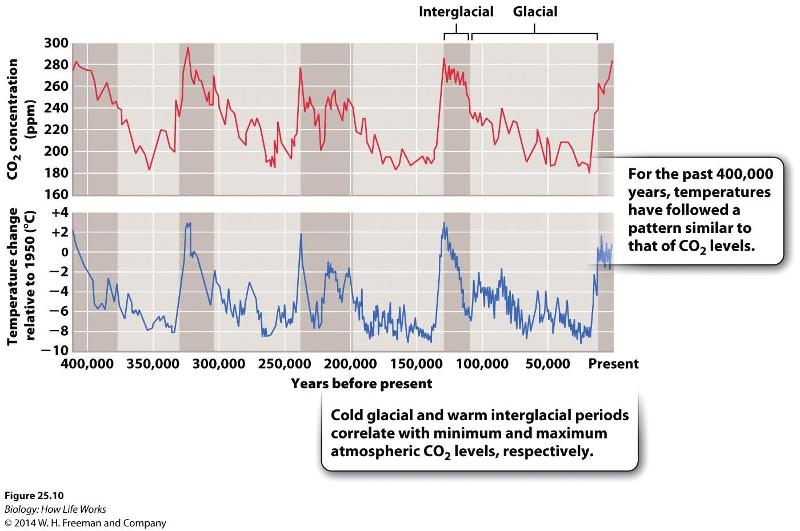
Examine the figure below, which shows the parallel history of atmospheric CO2 levels and surface temperature over the last 400,000 years based on measurements of air bubbles trapped in glacial ice sheets in Antarctica. Glacial expansion correlates with ____________ amounts of CO2 in the atmosphere and temperatures ____________ than those measured in 1950.
Select one:
a. decreasing; lower
b. increasing; higher
b. increasing; higher
Using records taken by Henry David Thoreau in the 1840’s, scientists
have documented what pattern of change in flowering plants around
Boston, Massachusetts?
Select one:
a. As temperatures have
warmed, flowering occurs earlier in many species.
b. As
temperatures have warmed, flowering occurs later in many
species.
c. As temperatures have become more variable, flowering
occurs earlier in many species.
d. As temperatures have become
more variable, flowering occurs later in many species.
e. As
extreme weather events have become more common, flowering occurs
earlier in many species.
a. As temperatures have warmed, flowering occurs earlier in many species.
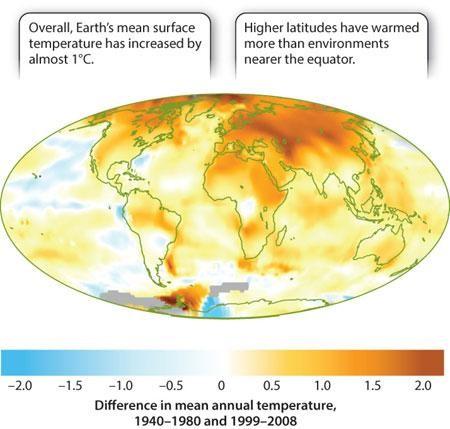
According to this figure, mean temperature changes from 1940–1980 and
1999–2008 have been greatest:
Select one:
a. in Australia
b. in southern
Africa
c. near the equator
d. in South America
e. in
the northern hemisphere
e. in the northern hemisphere
Researchers have found that:
Select one:
a. Increasing
acidification of the oceans does not impact coral skeleton
formation.
b. The increasingly alkaline oceans have impacted the
ability of corals to build skeletons.
c. The increasingly acidic
oceans have impacted the ability of corals to build skeleton.
d.
most marine organisms, including corals, are completely unaffected by
ocean acidification.
e. The increasing acidification of the
oceans has caused coral to build stronger skeletons.
c. The increasingly acidic oceans have impacted the ability of corals to build skeleton.
Oceans are about ____________ more acidic than they were in the
1960’s.
Select one:
a. 10%
b. 20%
c. 25%
d.
30%
e. 40%
d. 30%
In chapter 48 of Morris, the authors write that about ____________ of
the CO2 produced by humans during the past century has been absorbed
by the ocean.
Select one:
a. 1/4
b. 1/3
c.
1/6
d. 1/8
e. 1/16
b. 1/3